#((he's been discriminated for his nationality and for his addiction; and both he has a strong distaste for))
Explore tagged Tumblr posts
Text
@beatingheart-bride
"No, it doesn't, judging by the sound of it," Callahan nodded, before smiling to Lon and Erika, saying warmly, "But it could always use more Paces in it, I feel."
Even as breakfast continued to wind down and many of the spirits began to break away from the tables to begin their day, the Pace-Burke family remained seated a while longer, enjoying their drinks of choice and some much lighter conversation, the topic gradually shifting towards plans for the day: The Pace brothers were planning on further exploring the mansion and hanging out with some of the graveyard spirits, who they'd met and hit it off with the night before.
"You been teachin' these folks any games, Willy?" Colin asked, at which Wilhelm nodded as he set down his coffee mug, saying, "Oh yeah, I've taught 'em Rings, Crookey, Darts...been teachin' Lon and Erika as well, they've really taken to 'em!"
"Good to hear it!" Colin grinned, as Callahan rubbed his chin, saying, "Well, if anyone wants to join us, you know where we'll be-met those three odd fellows down in the crypt last night, was thinking about playing a little blackjack with 'em!"
"Just watch your wallet around Ezra if you do," Randall chuckled, as Josephine said, "Well, I'd like to spend a little more time getting to know my grandbabies. Is there anything you like to do together? Maybe something we can all have fun doing?"
"We like to watch movies!" Lon proclaimed proudly and excitedly, with Erika brightening a little at this suggestion. "We watch movies, and Papa likes to knit or sew while we do! Sometimes we all play board games while we watch!"
"Oh, that sounds like fun!" Josephine grinned, as Randall looked back down to Erika, who looked back up at him in turn. The question now was what she'd rather do: Play out in the graveyard with Uncle Colin and Uncle Callahan, or watch a movie with Grandma Josephine? Whatever she chose, he would go along with her for, as promised.
#((oh absolutely! in any other work; wilhelm would look down on his mother-in-law for her past career))#((and her pride in it; taking a sort of moral high ground as an irish catholic...but it wouldn't be like him to do so!))#((wilhelm is by nature a friendly and open-minded man; he takes people at face value when they meet))#((and so it just wouldn't be like him to have an attitude about josephine's past career!))#((that and as you rightfully pointed out; wilhelm knows what it's like to be discriminated against!))#((it *would* make him a hypocrite to discriminate against her; especially after what he's been through))#((he's been discriminated for his nationality and for his addiction; and both he has a strong distaste for))#((so it'd be very unlike him to be so discriminatory-if anything; i think he'd respect josephine))#((for marching to the beat of her own drum and doing what she wanted; and enjoying it too!))#((she enjoyed her work; and she worked hard at it: what more could wil ask of her? i think he'd respect that!))#outofhatboxes#beatingheart-bride#V:Two Worlds; One Family
6 notes
·
View notes
Text
Umakemenotwannadie
Chapter 1 ☆ Chapter 2 ☆ Chapter 3 ☆ Chapter 4 ☆ Chapter 5 ☆ Chapter 6
Sanji just needs a little love in a world that couldn’t care less



Modern magic AU. Zosan. Chapters: 6/?.
Trigger Warnings: depression, substance abuse, implied drug addiction, past childhood abuse, panic/anxiety attacks
One Piece Masterlist
Magic has been around since the beginning of time. It’s everywhere, invisible, but with a strong aura. Only people with magical abilities can perceive it.
It’s hard to say what really makes someone magical. It flows through some people’s veins and is part of their DNA. If you’re lucky, or unlucky, you have it. You’re able to physically feel and see it everywhere, while other people can’t even sense the strongest form of it.
It’s confusing and often brushed under the rug. Only about 1 in 15 people possess magical abilities. It’s legally not allowed to discriminate against people with magic, but it happens oh-so-often. It's human nature to gravitate towards people who are similar, which is probably why non-magical users are not often fond of users. It might be jealousy, uncertainty or straight up racism, but that’s the way of the world for you.
Sanji is very much aware of this. He comes from a strong line of magic users. The Vinsmoke family is a well-known, powerful family, with insane scientific connections. He comes from a bloodline of the strongest magic users in history . Not that many people would recognise the name, not with the blatant prejudice society fosters. Magic history isn’t being taught in school. Actually, nothing magic-related is taught in school, besides ‘’there are people under us who possess abilities. They’re not different from us.’’
Yet Sanji feels different from everyone. He loathes non-magic users for not carrying this burden. He loathes magic users for being able to live with pride.
His family had been strong and powerful enough to know more about magic than even most intellectuals. They were able to choose their children’s magical abilities. A successful experiment like that would’ve been groundbreaking if his family was out for anything but military strength. They would never share their discoveries, simply build their country stronger and stronger, keeping their secrets under the rug for other nations only to wonder.
But Sanji failed.
Sanji was meant to foster an incredibly powerful ability. He was meant to be an elemental, to be able to manipulate and control one of the classical elements of nature through magic. His father had expected him to be a lightning user; he was supposed to be powerful and strong, a born leader to symbolise speed. But all he could do was feel auras.
When Sanji was younger, he liked his ability. Everywhere he looked, he saw splashes of different colours. He was often able to read people’s emotions before they were even aware of their feelings themselves. He could offer comfort to his sister when she tried to hide her blue sadness, or completely indulge in his mother’s never-ending yellow, happy aura. Upon touching her, his whole body would tingle and sometimes, only when he was really lucky, was he able to physically hear her thoughts. He would wrap his arms around his mother and all he could hear was ‘’I love you, I’m so happy to have you.’’
By age 21, he absolutely despises his ability.
It took him a long time to be able to leave his home country. The problem wasn’t that his father wanted him there, it was that he didn’t want him anywhere.
Once he finally found an opening to leave, he took the opportunity with both hands.
He knows he’s incredibly lucky to have financial stability thanks to his family’s wealth, even though the money feels dirty to him. Living in a hotel room with only one suitcase for months on end was hell .
His university didn’t offer any student housing, and it was close to impossible to find a place on his own in the tight housing market. He had looked everywhere for anyone who was looking for a roommate. Why was it so hard to find a decent living space? He had already responded to numerous roommate advertisements, but honestly, most of them were either creeps or the place was disgusting. Yes, Sanji came from a royal family and his standards might be a bit above average, but was he really asking for too much? Especially that one dude that kept asking if he was into men, which was weird enough, but when he arrived at the place for an apartment tour, found out they would have to share a twin-sized bed. No, thank you.
All the negative experiences he’s had were probably the reason Sanji’s not very optimistic about his new roommate screening. Sanji had heard a woman over the phone, and he was over the moon to hear there would be another woman joining in on their coffee date. Whatever, even if he doesn’t like the place, he at least gets to drink coffee with two beautiful women.
He arrives at the coffee place way too early, not wanting to let either of the ladies wait. He is pleasantly surprised at the place they picked out. The coffee shop smells warm and inviting, the walls are adorned with vintage antiques and potted plants.
He orders a coffee before sitting down. He sends a quick text to the girl he spoke to on the phone, Nami, letting her know he’s arrived.
It only takes about five minutes for the two to arrive. Nami finds him immediately, much to his surprise. He hadn’t told her much about his appearance besides being blonde.
‘’You’re Sanji, right? It’s so nice to meet you!’’ Nami smiles cheerfully. She sticks out her hand for a handshake, but Sanji just kind of.. Ignores it.
‘’I am, I take it you are Nami? You look absolutely stunning today, my love,’’ he smiles at her.
She looks a bit taken aback, pulling her hand back as she sits down across from him. ‘’Okay… Thank you.’’
‘’I’m sorry about my manners, I’m not very fond of physical contact,’’ Sanji sips his coffee as he speaks. Okay, he might be partly at fault for not having had any luck with finding a roommate.
Luckily, Nami doesn’t seem to care. ‘’That’s fine! Robin came with me to meet you.’’
Right at that moment, the most beautiful raven-haired woman walks up to his table with two cups of coffee. For a moment, Sanji is scared he’ll get a nosebleed. If his awkward introduction hadn’t turned the orange-haired off yet, that surely would have.
‘’Hello Sanji, my name is Robin,’’ she smiles at him, much to his luck she doesn’t try to touch him. ‘’It’s nice to meet you. We’re happy you reacted to our advertisement, it’s quite hard finding a new member for a house full of people.’’
‘’I’m not turned off by the number of people, my dear. May I ask, is everyone as stunning as you two?’’
Robin laughs behind her hand and Sanji swears his heart skips at least three beats.
‘’We’re the only women, the other six are men,’’ Nami says.
He could have expected that. He also could have expected the additional information they provide. He would have to room with one of the males.
‘’He’s not in town right now, that’s why we’re the ones interviewing you,’’ Nami tells him.
‘’We’re a very good judge of character, so don’t worry. If we like you, they’ll like you as well,’’ Robin reassures him.
Sanji couldn’t care less about whether they’ll like him. He’d cut off his right foot right here, right now, to live with these two beauties.
Their talk is surprisingly pleasant. They find out they all go to the same university. Nami is lovely, though she can be a bit overwhelming. She dominates the conversation, yet doesn’t shy away from Sanji’s open flirtations. Robin is a whole other story. Sanji finds out they share many interests, but she is more reserved and quiet. For the first time, Sanji can actually see himself becoming friends with his potential housemates.
They talk a lot about themselves and their housemates. He learns about the six other males, how the seventh left a while back due to relationship issues. The bed has been empty for a while, and a new roommate isn’t necessarily needed, so they want to be sure it’ll be a good fit.
‘’Zoro always does better with a roommate,’’ Robin explains. ‘’He’s in his room alone too much, he forgets to take care of himself.’’
The place is an old house, fully equipped with a garden, kitchen, living room and five bedrooms. It sounds like a dream to Sanji. He hasn’t made any friends yet, so living with eight other people who go to his university sounds perfect. If all he has to do is make sure this Zoro doesn’t forget to eat and shower, it’s a perfect condition to be able to live with Nami and Robin. Also, the idea of finally having a kitchen makes his hands itch with the need to cook.
Nami rounds up the conversation, ‘’I think we’re on the same page with you, Sanji. If you’d like to come see the house sometime, you’re welcome.’’
Sanji could barely contain his excitement thinking about being able to walk into their home, and possibly being able to call it his soon. ‘’I’d love that.’’
‘’Actually…’’ At Robin's words, Sanji sits down again. Why is there always a catch?
She looks over at Nami, ‘’There’s one more thing…’’
Nami’s eyes widened, ‘’Right! Well, are you comfortable around magic?’’
Sanji stares at her.
No, absolutely not. He despises it. But the whole situation sounds so perfect. Will he really have to decline this perfect living arrangement because he’s scared of some unnoticeable little thing?
He thinks about it for a moment. Sanji doesn’t sense magic anymore. He’s been taking pills to suppress his magical abilities for years. He doesn’t want to see or feel anyone’s auras, that’s part of an old life, long left behind.
Nami continues, ‘’I’m a meteoromancer.’’
Sanji looks at her confused. ‘’A.. A what?’’
‘’Basically, I’m able to control the weather,’’ she explains. ‘’It’s not something you’ll be able to notice, but just to be sure. Some non-magic users are uncomfortable around it.’’
Sanji nods, still looking a bit uncertain. The pills suppress his abilities enough that others don’t even sense the magic running through his veins anymore. Sometimes, Sanji almost forgets it himself.
The answer is no, he’s not comfortable around magic. But if it’s only Nami, and it’s such a small little thing on such a beautiful woman, it shouldn’t be a problem, right? It’s not like she’s going to run into his room at night to call up a rainstorm. He probably won’t even notice.
‘’That’s fine. I’m not uncomfortable around it. Just... I would appreciate you not using it around me, if that’s okay.’’
Nami nods. She looks a bit uncomfortable, which makes Sanji want to punch himself. Did he really mess it up now?
Nami looks over at Robin, who smiles reassuringly at her. ‘’It’s okay. He’s fine with it.’’
She returns her gaze to Sanji. ‘’When would you be able to come over to take a look at the house?’’
─ ⊹ ⊱ ☆ ⊰ ⊹ ─
They decide on the next day. Sanji wants to be out of that god-awful hotel room as soon as possible, and the girls don’t seem to mind his eagerness.
It takes him a couple of wrong turns to end up at the correct house. He didn’t expect it to be this big .
He had put extra care in his outfit, wanting to look his best to meet his other potential housemates. He’s still sitting in his car, fixing his hair in the rearview mirror, when the door of the house opens.
‘’Sanji!’’ Robin smiles at him.
He’s taken aback by how beautiful she is again. She must have seen him arrive, and seen him try to reorganise himself in the mirror, which makes his face blush slightly with embarrassment.
He walks out to greet her. She takes his jacket in the entryway, smiling at him all the time. ‘’You look lovely, Sanji.’’
His blush deepens, ‘’I could say the same for you, my love. Please, don’t flatter me like that.’’
She leads him to the living room, and it’s like he’s slammed in the face by cosiness.
Everything has the same vibe as the coffee shop. It’s lovely, full of different kinds of plants and old antiques. The furniture doesn’t seem to match, but it still seems to fit perfectly right.
‘’Would you like something to drink? Coffee?’’
Sanji nods as he follows her into the open kitchen. The French door is opened, sharing the beautiful view of the garden. Sanji’s eyes couldn’t stop taking everything in. The kitchen is beautiful, it would be perfect to cook here for Robin.
‘’Sit down, everyone should arrive shortly,’’ she smiles.
Sanji nods as he takes a seat. The moment he does, he can hear a commotion upstairs.
Nami enters the kitchen first, beautiful as ever, followed by three other men.
Thankfully, Nami seems to have told them about Sanji’s no-touching rule. Everyone stays within a clear distance. They introduce themselves as Brook, Chopper and Franky.
Chopper is adorable. He’s smaller than Sanji and obviously very shy, but once Sanji starts to ask about his occupation, he becomes enthusiastic. He tells Sanji all about his anatomy classes and medical ethics, and even though Sanji doesn’t understand even half of it, he enjoys listening. Brook and Franky are nice as well. Brook is a music major, while Franky studies mechanical engineering. Sanji doesn’t understand much of both, but kindly listens and answers their questions. They’re very interested in his life and interests, and, for the first time, Sanji is excited to talk about himself.
It takes Sanji two cups of coffee before they finish talking. It hurts Sanji to know they might still turn him down, because he can already feel them weaving their way into his heart.
In the end, Nami takes him to the bedroom. It’s in the attic, and actually very spacious. The left part of the room is undecorated, only a single bed and an empty closet remains, which Sanji can use. The other side of the room is scarcely decorated. Some blankets are thrown over the bed and a couple of clothing items lay scattered among his part of the room. The wall doesn’t hold much personality, only a couple of pictures of the housemates, including a green-haired man with a mean frown, a brunette with a big grin and a straw hat, and a dark-skinned man with an adorable smile.
Sanji walks over to take a better look at the pictures.
‘’That one was taken when we just moved in. The dark-skinned guy is Usopp. He’s at work now. The green one is Zoro, and the other one is Luffy.’’
Sanji hums. Hearing the stories of their friends, they seem like lovely people. If he’s allowed to move in here, will he be able to fit in?
‘’So, what do you think?’’ Nami asks him.
Fuck, why does he have to answer first? It’ll be really awkward if he wants to stay, but they want to turn him down.
‘’Ah..’’ He stutters, ‘’Well… If you’ll have me, I think I’d like it here.’’
Nami smiles brightly, ‘’Good! I was hoping for that!’’
Sanji basks in the happiness she radiates. He tries not to let the anxiety of meeting the others get to him. ‘’Are you sure Zoro and Luffy and.. Usopp? Will be okay with it? Don’t you have to discuss this with everyone?’’
Nami waves him off as she walks towards the corridor, ‘’Don’t worry, Luffy has already chosen you.’’
He stares at her back, trying to figure out what the fuck that means.
She turns around as soon as she realises he’s not following her. ‘’What?’’
He shakes his head. It doesn’t matter. He’s finally found a place to live.
‘’When can I move in?’’
─ ⊹ ⊱ ☆ ⊰ ⊹ ─
According to Nami, he could move in the next day. Sanji would love to, but he knows he needs some time to process. His life has changed so much in the past few months, he needs a weekend to mull over the consequences of moving into a house with eight other people. He’s going to be sharing a room with a man he doesn’t know, even though he trusts everyone’s opinion that Zoro will be fine with it.
‘’I’ve never met someone who’s easier than Zoro,’’ Nami told him. ‘’As long as you don’t keep him up all night and don’t keep him from doing his workouts, he’ll leave you alone.’’
Additionally, he’s going to move into the house of a magic user. Realistically, he has nothing to fear. Magic users aren’t bad people, but Sanji knows best of everyone the dark pits of hell magic can create. His suppressants have worked for years, he’s probably not even going to notice anything about Nami. Plus, he still has his own room, which seems to be a safe space. Zoro doesn’t have much clutter or belongings, and absolutely nothing that could indicate anything magic-related. So he has nothing to worry about.
The anxiety doesn’t fully settle down though. The whole weekend he spends in his hotel room, he can feel the anxiety slowly coursing through his veins. Sanji tries to distract himself by enjoying his last weekend in privacy. He’s excited to move in and start a new chapter in his life, excited to finally make new friends and have a social life, yet he’s also an introvert. He enjoys solitude, being able to wake up whenever he wants and go to bed as late as he wants. He can jerk off without having to worry about someone walking in, which is something he definitely does not try to make the most of.
Once Monday rolls around, he’s ready to leave this sad, pathetic part of his life behind. When he closes the door of his hotel room for the last time, he promises himself to leave the last remaining part of his family he carries with him, too.
He skips his lectures on Monday. Rather, he stands on the front step of his new home with his suitcase in the early morning. Brook lets him in with a sweet smile, grey eyes going over the only piece of luggage he bought with him. ‘’Is that everything?’’
Sanji nods, embarrassed. He couldn’t take much with him and didn’t need much in his hotel room.
‘’Oh… Well, I was planning on helping you unpack, but I don’t think we’ll have much work with that, then.’’
Sanji’s heart almost burst at his kindness.
They spend the morning together. Brook lay on Zoro’s bed, blankets now thrown on the ground, so he could lie more comfortably. They get to know each other more as Sanji clears out his suitcase. It’s mainly clothes and a couple of trinkets he’d bought from home and in the weeks of his stay in town.
‘’Do you have plans for today?’’ Brook asks him once he’s almost done.
‘’I actually wanted to buy a desk and some groceries. I was planning on cooking for everyone tonight.’’
Brook’s eyes lit up at his request. ‘’You can cook?’’
‘’I love it. I haven’t been able to since I moved here. Is it okay if I make dinner for everyone tonight?’’
He nods so hard, Sanji thinks his head might fall off. ‘’No one can cook in the house, we usually come by, but we kind of live on take out and instant noodles.’’
Sanji laughs. “Don’t worry, food won’t be a problem with me around.”
Brook generously joins Sanji on his hunt from store to store. As he had promised, the house doesn’t offer many raw ingredients: they spend a lot of time picking up groceries. Brook even goes with him to buy a new desk and set it up, for which Sanji can’t thank him enough.
Brook adds Sanji to the house’s group chat, which is called “the straw hats” for some reason. Sanji suspects it's due to Luffy and the ridiculous straw hat he’s sporting in all of Zoro’s pictures, but he doesn’t ask further questions. He has enough time to learn about house dynamics later.
But first, dinner. Brook lets everyone know Sanji is cooking that night. He makes curry, Brook’s favourite as a little thank you for all the help, and everyone seems to love it. Robin generously showers him with compliments, meanwhile, Chopper asks for thirds, and Nami warns him of the storm that is Luffy when it comes to food. He even gets to meet Usopp, who’s a little shy and eccentric, but Sanji doesn’t mind one bit.
“All the plants are mine,” Usopp tells him proudly in between big bites of curry. “I’m a herbalist.”
Sanji chokes on his food. He can feel his face start to heat up uncomfortably as he coughs. Chopper makes way to slap him in the back, but Sanji panicky stands up before he can reach him.
He doesn’t miss the disapproving stare Nami gives Chopper, or the kick under the table Usopp receives from Brook.
While Sanji slowly comes down from his coughing fit with a glass of water, Usopp continues awkwardly. “I really like plants.”
Sanji nods, gulping the last of his water inside before swallowing. He thought Nami was the only one. With Nami, he can deal, but two of them? This is not what he signed up for.
He returns to the table to finish dinner. It’s too late to back down now anyway. If he can deal with Nami, he’s not going to leave because of Usopp.
“So… are they magical? The plants?” Please say no, please say no, please say no..
“Oh no! I’m not allowed to have magical plants in the shared spaces any more thanks to someone.” Usopp side-eyes Chopper as he speaks.
“That flower almost bit me!”
“Peony does not bite, she is friendly!”
“She was eyeing me for months before she tried to eat me when I was alone!”
“She needs personal space, you were too into her face!”
“Boys, please, no fighting on Sanji’s first night,” Robin comes between them.
Sanji just stares at them. They’re all so comfortable with everything. He’s not sure whether he is envious or scared, but he is certainly uneasy.
“Sorry Sanji,” Chopper apologises.
“I didn’t mean to make you uncomfortable,” Usopp says.
“It’s okay,” Sanji smiles at them. He’s not used to this, to them, yet, but he wants to be. He already felt more at home for the past 9 hours than he’s ever felt in his childhood home. “I’m not uncomfortable.”
It’s quiet for a second.
“You don’t have to lie to us,” Nami says .
Robin smiles at him, “We live together now. You can be honest.”
Sanji nods, she’s right. “It’s just.. A bit new to me.”
He doesn’t let on that magic isn’t new to him, the ease with which they talk about it is.
“I think this is the best curry I’ve ever had. Thank you so much, Sanji,” Brook suddenly praises him.
Sanji is glad for the distraction. He smiles and thanks him. “I’m going to cook a lot more often.”
A couple of hours later, he finally enters his new room. Exhausted, he lay down on his bed. The few non-clothing articles are still in his suitcase, but besides that, his part of the room is completely his .
He smiles as he closes his eyes. He could get used to this.
Chapter 1 ☆ Chapter 2 ☆ Chapter 3 ☆ Chapter 4 ☆ Chapter 5 ☆ Chapter 6
#one piece#black leg sanji#zosan#zosan fic#masterlist#op zosan#op masterlist#ao3#sanji#vinsmoke sanji#one piece sanji#roronoa zoro#mugiwara no ichimi#angst#one piece angst#angst comfort#fluff#one piece zoro#robin one piece#zosan fanfic#fanfic rec#fanfic writing#one piece masterlist#hurt/comfort#angst/comfort#light angst#one piece nami#modern magic#modern magic au
15 notes
·
View notes
Note
Hey Caro ☺️ I just took your super m quiz - thanks for making such a fun quiz, I feel like it helped me get into super m! I know nothing about them yet but I thought it fit soo well that I got Kai bc I’m a full time dancer - now you have me super curious about him 👀👀
KAI :: INTRODUCTION MASTERPOST (dance focus)
so you wanna know about the god of k-pop choreo? oh yeah, i’ll talk to you about fucking kai! if you dance, this guy is the #1 must-know. once you see him move, there’s no going back. i don’t exaggerate: kai is the gold standard. brace yourselves, i’ll show you why.
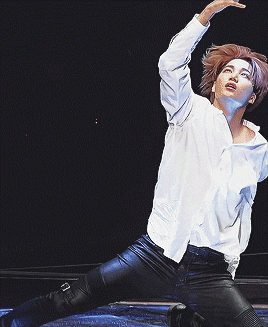
kim kai aka kim jongin (27) is a solo artist and super m’s plus exo’s main dancer — est 2019 and 2012 respectively — heading either group with a passionate, hyper-physical style that roots in his early practice of of jazz dance and ballet. the influence definitely shows.

learning choreography, he’s become the gorgeous fusion of emotional grace and explosive power that unites both tension and extreme accuracy. while at the same time: never sacrificing his interpretation. and HOW MUCH HE BLEEDS FOR HIS CRAFT. he enjoys it so much.
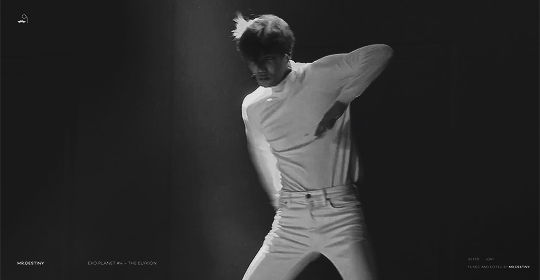
and he’s communicating it 100%, jongin’s dance is so interactive and raw, luring. i swear to god, put the seatbelts on for this one. it’s never just him, it’s you as well. you’ve never seen this before. he’s like “yes, i meant you, i’m looking at you”:
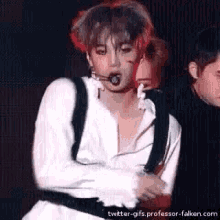
he’s even gonna modify the choreography to point right at you to underline that very thought. he’s so good, he can learn it, ace it, epitomize it, and do his own thing anyway. even the person in the last row will get whatever point kai wants to make. this is dance that belongs on the biggest stages.

even when he films without a crowd, it’s like you’re literally standing opposite to him. he focuses on two people: his moves, and the viewer. he has it look like you made him smile and self-aware, or you made him determined. INCREDIBLE. he shows his charisma, BUT he also shows your own (!) impact on him. it’s a duet. he wants you to join him on the dancefloor. this is from exo’s call me baby mv where kai does his famous come-hither:
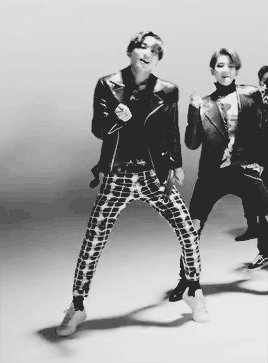
he flirts and he encourages. he values the audience and wants them to be confident as well. i think it’s the reason why he’s so outstanding and addictive, kai thinks beyond himself. it’s a tango he involves you in with his eyes and how he opens his body, interprets a lyric.
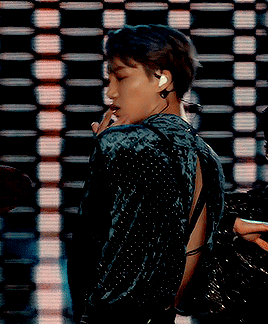
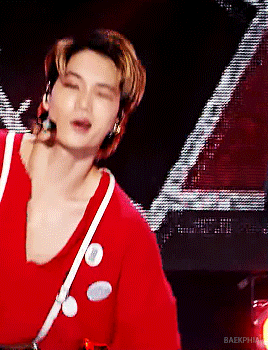

it’s not about imposing himself going one way. instead: he plays the back and forth ALL. THE. TIME. in any context. whether it be frivolous, or fun, or gloomy, or sweet. even with a simple little smiley wink it’s happening. and he acts like you had a reaction to it. there’s literally just a camera.
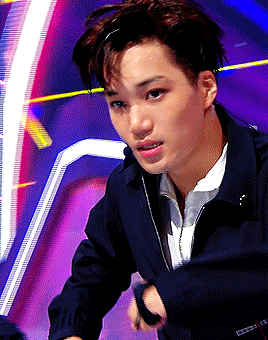
this guy’s physique, strength, elegance, feeling for the beat, character portrayal (!), and control is unbelievable. he’s destroyed it in every fancam out there. he can’t switch it off even if he tried. your eyes would go toward him in the largest group formation still. put him in the center, that’s his spot, he showcases it.

because he doesn’t just show learned moves, he makes it radiate something dynamic and animalistic (he embodies superm’s ‘tiger inside’ all the way).
jongin’s dance says: i love this, you love this, let’s do this, the feeling is right. he makes bodies and unrestrained touch the opposite of wrong, he pronounces it a source of having fun and being instinctual. and he never breaks the tie with you throughout, and uses his shoulders and lips to put the oomph into it.

he uses innuendo and a ‘we both know’ sentiment perfectly as an invitation rather than just going through his routine. that’s how he can make each move fascinating. you can tell kai knows exactly how to make everyone scream their lungs out. i bet somebody held their breath just reading this post already.
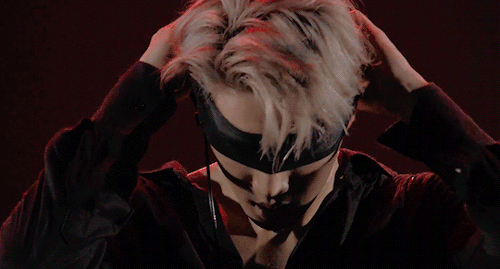
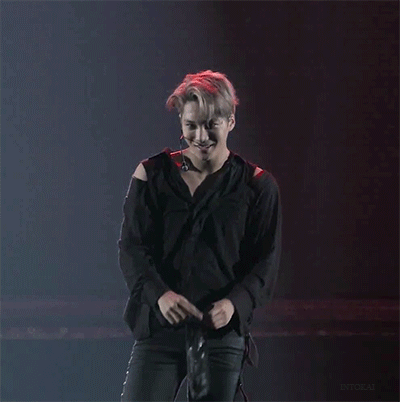
exo’s most famous choreo is ‘monster’ (kai focus linked) with good reason: jongin can turn himself into nothing short of a roaring beast. it’s one sharp, complex move after the other. kai can bend any gravitational law he wants to show any feeling and pose he wants. a glimpse:
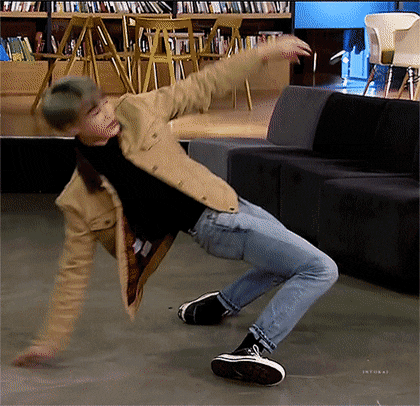
now, how to spot him in general if you’re new to him? here are some pointers. kai’s execution is clean, fast, and powerful. those are two decades (!) of experience showing. kai is an all or nothing dancer, he plays no games. he treats every group and solo stage like his best and last. his work ethic is beyond words. yeah, he’s a capricorn. his style is direct as can be, working every axis.

as you can see, jongin is hard to overlook anyway: he’s a 182cm giant made of steel. he strives to acutely visualize impact in his style and it is always successful. in fact, it’s his signature. it’s like he creates invisible objects and pushes through them. boom, he just burst another bubble.
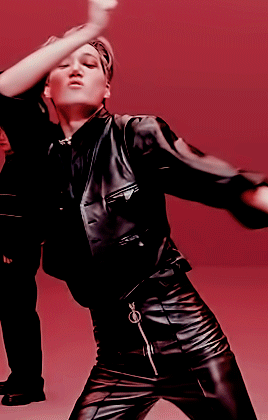
when the song gets to his part, i guarantee you won’t miss him and all the boldness and expression he brings to enrich the performance. hell... he carries it. jongin can handle the center, i’m telling you. (look how fast he rotates here)
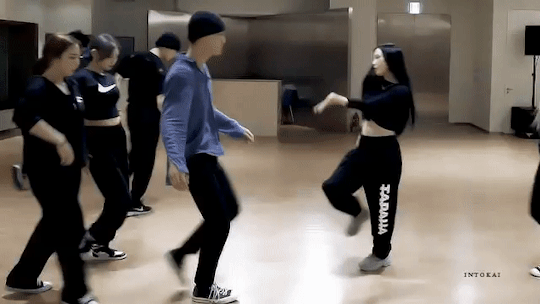
talking features — this is what to look for when he dances in a group setting: you can recognize kai’s face by how wide, bluntly structured and sensual it is. jongin is a sight. he has such an aura, serious, sultry, and smiling alike.
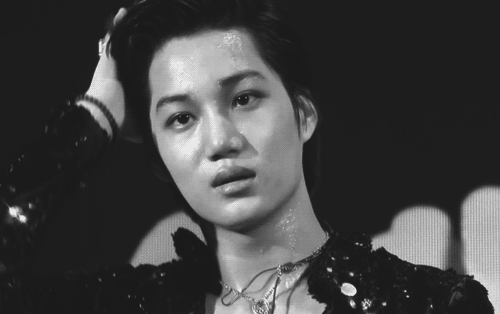
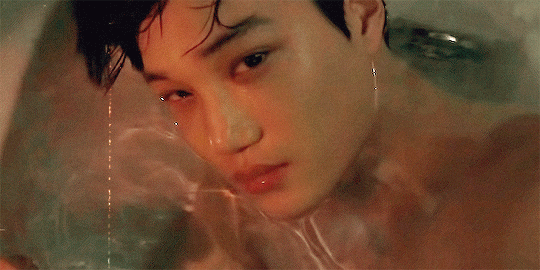
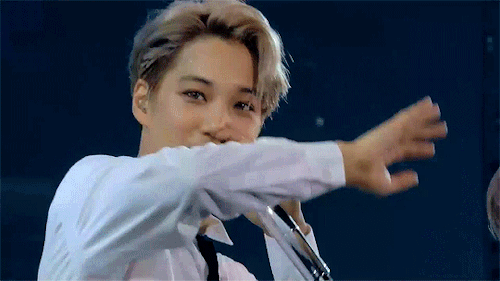
with a very recognizable silhouette (like... holy hell!):


he’s very cute as well ♡ the fandom and kai himself have an adorable analogy going on. jongin calls himself a teddy/nini bear and we joined in on it. (i made a thread about it here, it talks more about his offstage life) — hence kai’s fans are called eri-gom, eris as in exo’s fanbase and gom meaning bear.

and i mean. look at him. what an attractive guy. he’s that handsome. strong brows, teddy eyes, square jaw, swept hair, glorious lips, tan skin.

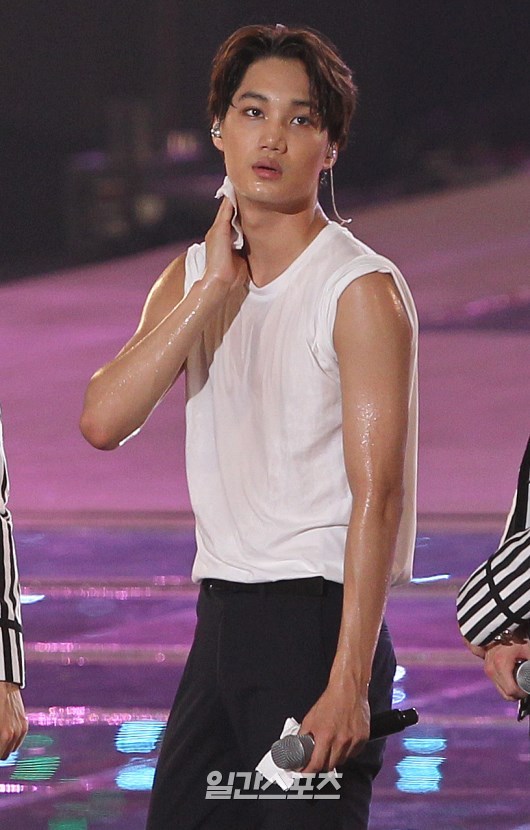
now yes, something important concerning his appearance and a serious topic: i don’t want to list you the endless instances of colorism that kai has to endure but it has to be mentioned. jongin has been called every name in the book and people agonize him over his skin incessantly. it goes on and on and on. every day a new terrible comment about him emerges because some pitiful person thought it was funny and would elevate them.
he’s had to deflect, ignore, reframe, defend, remotivate, assert, harden, prove, denounce, and push himself, protect his confidence, decline skin bleaching constantly, laugh along, dance and practice thrice as hard to get the respect, and still see his dignity torn to pieces all day. i’ll just give it to you straight, that’s all fucked up. kai’s skin is perfect, he’s amazing and wonderful.

in his own words:

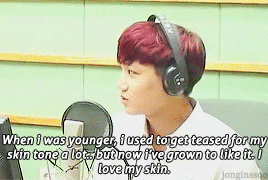

— exactly right. say it even louder.
having him at the bottom of every joke is weird and messed up. this man is an utter beauty and nothing has to be fixed. it is up to him to define himself rather than get called ugly for his skin’s appearance by default, and get whitewashed at every opportunity. it’s been going on for 27 years, he scrunitizes himself all the time and doesn’t look at himself fondly because he hears these beatdowns daily.

it’s heartbreaking that this happens literally with no end in sight (’kai is just a stripper!’... ‘he has bad vibes’... ‘darkest guy jongin!’). for his skin, and how he decides to show it, too. jesus christ his skin looks fantastic, end of debate. they just can’t handle him, kai couldn’t be any more immaculate.

♡

jongin has vigorously protected fans from discrimination, bullies, and shaming himself whenever it came up. in a very straightforward and deadpan manner because he knows exactly how it damages you. (”J” in the subtitles = jongin, he’s wearing the plain white top at the very back)
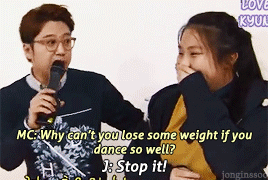
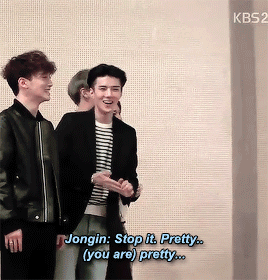
we need to protect and praise him that way right back. it’s important.
so, needless to say. all in for jongin getting the center stage he deserves. because he has the wow factor in every regard. kai usually opens an MV because there’s no better way to get people’s attention with that level of presence. with kai, you can’t go wrong. if you get the center in a an all star group like superm, you are the king.

being part of that presence, kai’s stage alter ego has reached levels of infamity you can’t even imagine. it’s great to see him being sovereign without apology.
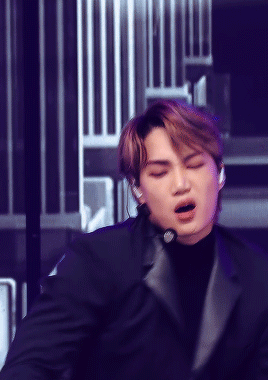
and it doesn’t stop there. he shows time and again that acting, props, and commanding the audience has to be mastered to be an exceptional dancer. kai owns his sex appeal. sometimes, he even dances a portion of choreo with his eyes closed because he’s feeling it so much.
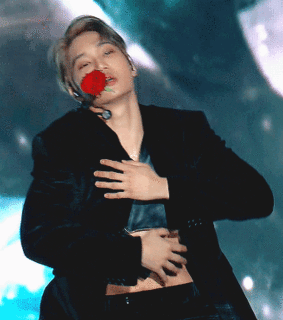
he is a pro in using his surroundings as well, superm’s stages are a glorious opportunity for kai to show how he comfortably ‘lives in’ the 3D space around him.
which makes the viewer do the same: watching kai makes you feel amazing, energized, but also serene and enjoying the moment.

there’s always balance. it’s the magic of it. e.g. he comes along with so much impetus and decisiveness but eventually, he halts to offer himself. here i am — take me. i’m yours. closed arms, open arms. walking, kneeling. looking down, looking up.

kai goes every extra mile there ever was and makes each eye contact count. involving the audience, one grin at a time. it works. it’s about establishing contact. he connects to the onlooker with so much nuance.
kai’s smirk is notorious and you can see why it’s so raw and real: he makes it linger. it’s such a duality since his dancing says i’ll come over, while his message is come and get me, i know what’s on your mind.
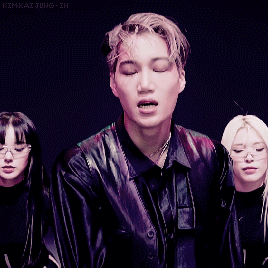
with a hilarious twist – kai expertly uses humor. you don’t get that in many dancer repertoires. i love it. all those quick expression changes. his smile! 😊 what a man.

so — what makes him so good and known: yes, his style doesn’t deny that dancing and eroticism are one in his business. that takes courage. kai has it. iconic performances have been his reward. point dance/killing part: exo’s love shot choreo.
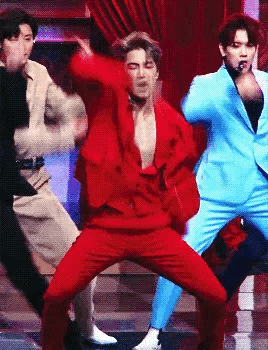
that suit has swept the nation. what’s more: kai shows you it’s more than just good hip movement that a good dancer needs. he does everything at once, he puts the pleasure on his face, all his limbs are following the template he chooses.
the thing is. kai couldn’t be any shyer, but when the music starts he becomes a oscar-winning madman. he emotes constantly (!) and stays in character. this is gold.

jongin always plays it up. he knows how to use that face and does a lot of power posing. this is how visceral looks like. he’s interpreted exo’s aggressive concepts to a T.
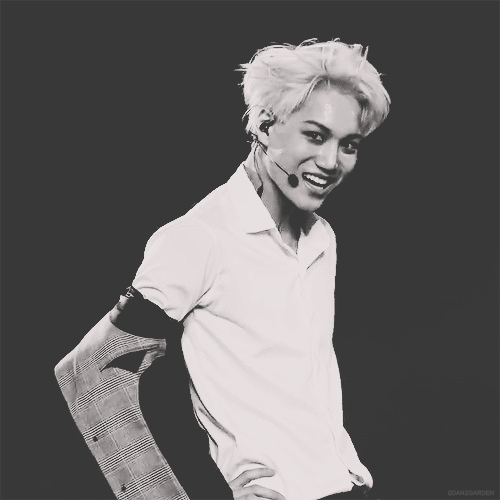

and he has so. much. fun. it propels him. on every beat.
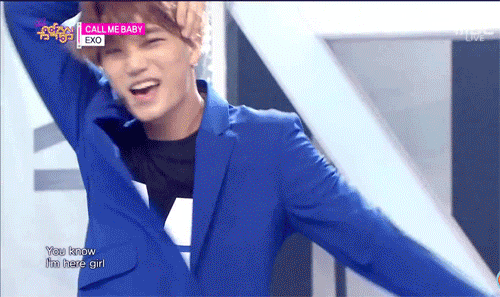
past every hurt, heartbreak and injury, man. if you know about his genre you knew this was coming, kai does all of that with 4 herniated discs. since debut days, never recovered. every gif in this thread, he dances with a battered spine. wheelchairs, stage collapses, relapse-recovery-schedule tales, the dilemma of injuries being inevitable, limping, kai falling into depression during breaks, constant pain killers, countless tears on stage, we’ve seen it all, the extreme end of it.
kai works out like hell to literally keep his body from falling apart. but it doesn’t help the nerves in his back that are impacted. doing choreo you can sometimes literally see the pain kicking in and he pulls himself through with force for the last minute. once you know how strained his back is, you can see it.
at the end his expression goes fuck now it’s coming when the adrenaline fades. he takes every second-pause he gets to rest but still finishes each move. even when he holds back, he keeps it together and executes each turn. sometimes, he has to restrict himself and soften his movements to protect his health (especially in hard choreographies such as lucky one which is universally disliked by exo — still jongin makes the very best of it smiling bright and dancing so hard his sleeves come off).
he frequently states he ‘dances in any case unless his legs are affected by something’. all torso injuries are fair game, this guy is hardcore. and people claim he’s just pretending. chen (a fellow exo member) says not a single part of jongin’s body is intact. he has paid every price to get this far to follow his love. he’ll step on stage with crutches. he works SO HARD.

that being said: exo being called the official nation’s group, i say kai is the nation’s dancer. period. he has had his great moment at the korean olympics flawlessly dancing in a hanbok with traditional instruments and fulfilling his dream.
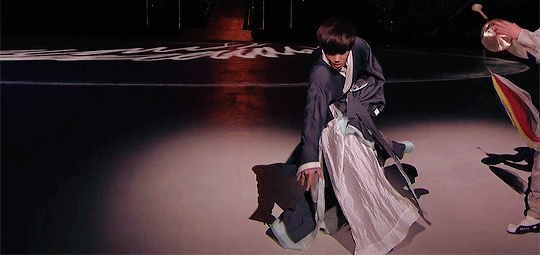
i love the tension and drama he can bring. he can also thrill with slow, vulnerable movements alike.

kai’s is called a legend, he’s all that and even more. the facial expressions alone are feared by any kai stan because they hit home.

this guy is a sex icon and goes off like a gun, messing around was never kai’s incentive.
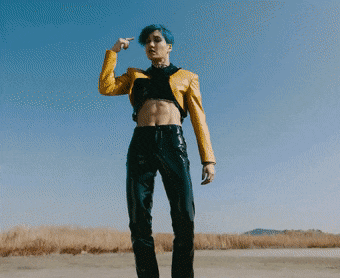
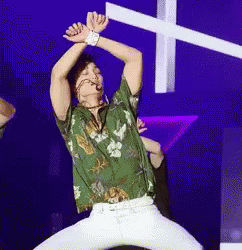
while at the same time being incredibly nuanced and so, so descriptive with his movements.
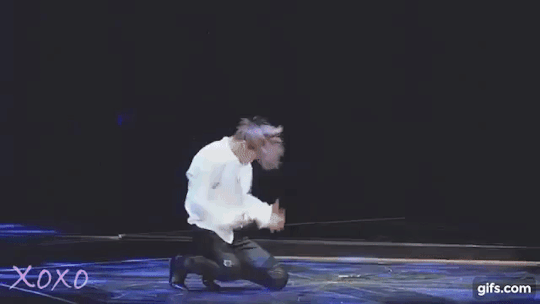
point dance: baby don’t cry. yep, kai has danced in water. must-watch.
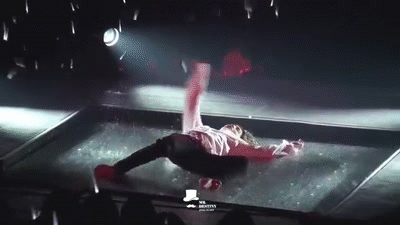
this man loves what he is doing. he said he wouldn’t regret to die on stage because dancing is his destiny. boy, it shows. this guy has found his purpose. he can tell any story he wants. he’s a complete artist.

he’s perfectly portraying his incentive and he couldn’t look any more like a god on earth.

long story short, kai is dance and motivation goals. if you dance professionally, you can easily look toward him for the right words.
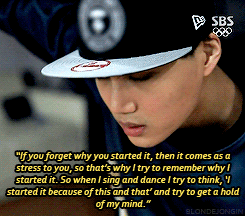
if you want to further your study and knowledge: he released a self-titled solo album recently. highly recommended. he worked forever on it, and he’s really dishing it on there. you get to hear his soft voice plus sizzling footwork. and he isn’t even getting started yet. you’ll hear from kai, i promise. he constantly achieves new levels of artistic perfection.
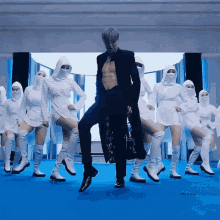
a last remark. jongin is amazing for a myriad of reasons that go beyond what i show you here given the post focuses on his work on stage. but the point stands, while other people have tried to break him, he broke through every barricade instead and stood up for himself. we can be extremely happy to have him and witnessing his unreal dance is an exceptional pleasure. here’s to jongin continuing his passion and confidence, healing, and getting the sweeping respect and acknowledgement that is his.

#kai#kim jongin#jongin#super m#exo#exo introduction#superm introduction#introduction posts#kim kai#erigom#ask#bulletproofgucci#cub mail 🐆#dance#dance analysis#flashing tw#injury tw#colorism tw#kai masterpost#long post#kai thread#exo thread#superm thread#jongin thread#jongin dance analysis
122 notes
·
View notes
Text
Thoughts on Grey’s Anatomy: 17X15
SPOILERS AHEAD!!!
Wow! A lot happened in this episode. It was billed as Jackson’s goodbye episode, but it turned out to be so much more than that. Meredith got discharged and was reunited with her kids, Tom decided to move to Boston to work for Jackson, and we got the show’s first Indigenous doctor and patient storyline! I honestly think Jackson’s farewell was really well done! While it’s true he could do the work he wants to do just as easily from Seattle everything else about his exit makes sense to me. He’s tired of sitting on the sidelines and he wants to make real change where he can.
I loved his conversation with Meredith and how he was the one to sneak her out. I loved Meredith's voice over for this episode and how it followed Jackson's actions and the flashback montage set to music. I thought it was fitting. I would have liked him to have said goodbye to Ben because they were the Plastics Posse until he left to become a firefighter but apart from that I was happy with it. The character has come such a long way during his run on the show and I feel like this episode reflected that.
The editing was really well done too. Especially the shot of him overlooking the lobby. That transition was seamless. I loved his goodbye scene with Meredith. It made me so emotional. I love that Meredith tried to lighten the mood by making a joke about how she won because she's the last one standing. That scene when she hugged the pillow after he left because she misses him and everyone else really got me. I also really liked the conversation he had with Bailey and Richard.
I'm glad he said a proper goodbye to Jo although I didn't find it super emotional. In addition to Ben, I would also like to have seen a goodbye with Maggie. I'm surprised they didn't do that. Maggie was so focused on Meredith's recovery that it's not clear if she even knows that Jackson is moving to Boston. They also could have done a big emotional scene with Catherine. On a lighter note, I am so happy that Meredith is doing better for real this time and has been discharged! I've been waiting for this since the mid-season point.
I loved the scene where she was reunited with her kids and Amelia was panicking about the state of the house and Meredith told her it was fine and that was just how she liked it. Meredith getting Jackson to sneak her out of the hospital felt very in character to me. As her voice over says Meredith isn't one for tradition or big hullabaloos which is why I think the others tried to keep it a secret. I'm not surprised that she ducked out early. While I get why the other characters wanted to do a big send off for her, I feel like they should know by now that's not her style.
I loved the scene where Amelia and Link found out Meredith might be coming home, and they hugged and then Link said he had to go to work and Amelia started crying and then asked why he was still there. Link was so confused and then Amelia told him she’d be crying off and on like that all day to get her emotions out and that she’d be fine and he needed to go to work. That is so Amelia! But in a good way. Post-tumour and with her addiction under control even in a pandemic Amelia is now able to express her emotions in a healthy way so she doesn’t relapse or spin out of control. That is such huge growth for her. I loved the scene at the end with her and Meredith.
The smile that they share. The look between them. You could see early seasons Private Practice Amelia in that look but also mature and stable new Amelia. I loved that Amelia was all worried about the state of the house and Meredith was fine with it being a mess because as a working Mom she knows what it’s like and all she wanted was to be at home with her kids in her messy house.
At the end of the episode we find out that Tom’s near death experience with COVID has caused him to re-evaluate his life. He feels lucky to have lived to have been spared and he wants to help Jackson make real change in Boston. On the one hand I was surprised by Tom’s exit, but on the other hand I wasn’t. I love Tom and will truly miss his character, but ever since the affair came out and he and Teddy split and she started working on trying to repair her relationship with Owen, Tom hasn't had a lot to do.
I'm sad they didn't do more with him because he's such a great and complex character and I know some people had speculated they might pair him up with Mama Ortiz which could have been interesting. I'm sad we didn't get to see him say goodbye to Amelia, Link, Teddy, Catherine, or Meredith. Tom and Amelia are old friends, he trained her, he took out her brain tumour, and she rushed to the hospital when she heard he had been admitted for COVID-19.
Tom and Link seemed to be getting along as of late and Tom was ready to be a father to Teddy's baby before she got back together with Owen. He found her the perfect apartment and he built a crib for a child that wasn’t biologically his that he was so excited to meet and be a Dad to. All this after his own son died and his marriage collapsed as a result. He treated her like gold and she’s done nothing but treat him horribly for no reason. I don't think I’ll ever forgive Teddy for that.
Catherine and Tom are also old friends that go back even farther. She appointed him as Chief Medical Officer of the Fox Foundation. She told him about DeLuca’s death and took him to the Memorial. When Richard was sick, she told him she wanted him to take over the Foundation in her absence. Tom and Meredith had such an emotional scene earlier this season and he's been praying for her every day. Does she know that? Does Meredith know that Tom has been praying for her and worrying about her? I was expecting a follow up scene to that, so I hope we get one.
I found the patient storyline that Tom, Levi, and Indigenous intern James Chee had really moving. Grey's has never had an Indigenous patient or doctor on the show before and while the dialogue did feel heavy handed at times, they brought some really important issues to light and were trying to make up for lost time so that’s understandable.
Robert I. Mesa who plays Dr. Chee is Navajo Soboba and the patients that they treat at Coast Salish whose traditional territory encompasses the province of British Columbia, Canada and the states of Washington and Oregon in the United States. It’s really great to see an Indigenous actor bring stories about Indigenous characters to life in a realistic way for the same reason that it’s important to see black, brown, Asian, latinx, and LGBTQ+ actors bring stories about characters like themselves to life. It brings authenticity and ensures sure that white straight cisgender people aren’t taking roles away from people within those communities.
When I found out through Twitter that the show had cast its first Indigenous doctor, I was very excited. I work for an Indigenous organization currently and so Indigenous representation is an issue that is very near and dear to my heart. The first thing that came to mind for me was the Coast Salish artwork you see in the background of so many scenes of the show. From the show’s earliest seasons, you can see beautiful art pieces in red, blue, and black depicting fish, birds, and other animals on the walls of the hospital and in people’s offices.
Yet it is never addressed or mentioned that that is Coast Salish artwork. In order for it to be there someone from the art department must have travelled to Seattle to buy some local artwork to put up around the hospital. While that’s great for making the hospital look authentic to the area by not mentioning its origins or the fact that Indigenous people exist for 16 seasons does all Indigenous people a disservice. Indigenous people are not stereotypes or tokens or simply makers of pretty pictures.
Every group has their own culture, artwork, language, and traditions. I’m glad that Grey’s Anatomy is finally acknowledging the existence of Indigenous Americans and the fact that Indigenous people exist and continue to exist despite repeated ruthless attempts to murder and assimilate them. This is a huge problem in the United States, Canada, Australia, New Zealand, and other nations. While in the last few years Indigenous issues have gotten greater coverage in Canadian media there isn’t as much media coverage of Indigenous issues in the United States.
I love that Tom and Levi treated both the pregnant woman and her grandfather with respect and dignity and didn't dismiss their concerns or mock their traditions. I love that Tom actually had some knowledge of smudging ceremonies and that he referred to Dr. Chee respectfully when needed and allowed him to perform a smudging ceremony for the grandfather. When the pregnant patient’s husband thanks them and says that in the past they haven’t had great experiences in big hospitals that is unfortunately a sad reality for many.
Like other people of people and other marginalized and oppressed groups the concerns of Indigenous patients are often not taken seriously, and they often encounter racism that leads to poorer treatment and death. When the pregnant patient talks about how their centres are under resourced and that they were sent body bags instead of medical supplies that is a real thing. The Trump Administration actually did that in the States and the Harper Government here in Canada did that during the H1N1 Epidemic.
Thankfully, here in Canada the COVID-19 Pandemic response of the Trudeau Government has been worlds better. No sending of body bags and instead medical supplies and lots of relief money has been given to Indigenous organizations like mine to help real people. Indigenous Canadians have also been given priority status for vaccinations and as a result people are alive today that would have died previously. Now that’s not to say things are perfect here. There are still so many issues that need to be addressed including police violence, discrimination within the justice system, and the rate of missing and murdered Indigenous women. But at least some progress is being made.
The fact that they wrote Tom off reminded of an old adage about Grey’s Anatomy that I heard someone talking about at the start of this season which is that if there isn’t anyone significant for a character to date and you’re not an original character your days on the show are numbered. The fact that they wrote Tom off after putting Teddy and Owen back together makes me even more sure that Meredith and Hayes are going to end up together and that their relationship will be a key plot point of Season 18.
If that wasn’t the plan, I don’t think Hayes would still be there. There have been episodes this season where he has been very prominent, episodes where he’s been completely absent, and episodes like this one where he has a few short scenes. He wouldn’t still be there hanging around in the background if the plan wasn’t to set him up with Meredith. To me the only explanation that makes sense is that they are going to put Meredith and Hayes together hopefully before Season 17 ends.
Side note, I bet all of the actors who passed on being Meredith’s love interest or backed out for a movie or tv role on a newer show probably feel real dumb right now. Grey’s is about to go into its 18th season and Richard Flood who plays Hayes is getting paid mad bank whether he’s prominently in the episode or not! Plus, he slays that role. While the path they took to get here was bumpy I’m so glad that we got Hayes as a character and we’ve gotten to see his relationship with Meredith develop.
I would have loved to see more of Hayes this episode. I was expecting a scene in which he visited Meredith and I was a bit disappointed we didn’t get that. I get that the focus of the episode was on Jackson’s departure, Meredith being discharged, and Tom’s epiphany, but it would have been nice to see that. The scenes we did get were great! I love his dry sense of humour and his comments about Jo’s terrible handwriting.
My favourite moment of the episode was hands down when Hayes came to clap out Meredith with everyone else and then Perez came out and they realized that she had snuck out early and Hayes laughed and said, "Nice one Grey, Brillant!" And then he wished everyone a good night and headed out. If Meredith isn't there, he's out. He’s not even trying to hide his feelings for Meredith anymore. It’s an open secret that he likes her and is clearly smitten. Hell, at this point I wouldn’t be surprised if the janitors have a group chat about it.
I love that he laughed about it like it was some big cosmic joke they were both in on. He knows her so well. Everyone else was confused and her sisters were worried when they didn’t hear from her, but Hayes wasn’t worried because he knew she’d snuck out the back and that someone must have helped her. Speaking of romance, I’m guessing that next season they will bring in a new Head of Plastic Surgery for Jo to date. I feel like they will have more luck finding someone than they did when they tried to hire a new love interest for Meredith over the last few years because right now work is scarce.
Also, in the romance department Teddy and Owen are back together. I'm happy for them, but other than that I don't really have any strong feelings about it. I am happy that they seem to be good and that the fighting and long-drawn-out drama is over. I've never been a ride or die Teddy and Owen shipper, so I don't feel an emotional rush seeing them back together. I loved Tom and Teddy together so I'm sorry that ended especially since Teddy and Owen have always been such a mess.
I think that they should have spent less time fighting and more time rebuilding their friendship before getting back together. We spent the first half of the season watching them fight non-stop and Owen made it clear he wanted nothing to do with Teddy ever again. Teddy treated Tom like crap while trying to win Owen back who clearly didn’t want her. While I’m glad they have reconciled, and the drama appears to be over I wish they had spent less time on the fighting and more time on exploring Teddy’s trauma and having them rebuild their friendship if that was the route they were going to go.
We also get more details about Maggie and Winston’s wedding this episode. I posited on Twitter a few days ago that I thought Maggie might ask both her dads Bill and Richard to walk her down the aisle as she'd want to include both of them in the ceremony. I think having Bill walk her down the aisle and Richard officiate is lovely. It reminds me of when Bailey stepped up to officiate Callie and Arizona's wedding.
I’d like to see more interactions between Meredith and Winston and Meredith and Link in the future as both men have become a part of the family largely while Meredith was sick so it would be great to see them get to know each other and bond. I really loved the scene between Winston, Link, and Owen where Winston was trying to figure out if Teddy and Owen were back together and Winston and Owen were teasing Link about the Sister House. It’s nice to see them all bond. It would be even better if they would all have more scenes with Hayes and for them to bond as well. I hope to see more of that next season.
I get why Link wants to get out of the Sister House, but I think he was a bit unrealistic about the situation. Meredith just got discharged. Amelia and Maggie aren’t going to want to leave her side until she tells them she’s ready and it’s okay for them to go and take a step back. I foresee them going with a hybrid approach next season where Maggie and Winston move to his place following the wedding and Link, Amelia, and Scout move to Link's place, but they still spend time at Meredith's house frequently. I imagine after being away from her kids for so long at some point Meredith is going to want her house back and to spend time alone with her kids.
I'm interested to see Meredith talk about her time on the beach in the upcoming episodes. Richard and Bailey were struggling to figure out how to tell her about DeLuca’s death but we the audience knew that Meredith already knew he had died. When she coded previously, and Ellis Grey passed away the first words out of her mouth were about her mother being dead. But here we see something different. When Meredith wakes up this season the first words out of her mouth are about how much she and Derek love Zola. She uses the word ‘we’ so the audience knows what she’s talking about, but the characters don’t.
It appears that at least a week has passed since the previous episode possibly two and we learn that Meredith hasn’t brought up her time on the beach or her visits from the dead to anyone. I think that she’s keeping that to herself for a few reasons. She didn’t want to leave the beach and telling that to the people who just spend the past three months trying desperately to save her life would probably come across as suicidal and upsetting. The conversations between her and Derek were personal and private, and she may not be ready to share them just yet.
Her conversations with George, Lexie, and Mark were also pretty personal so she might not be ready to talk about that either. In this episode we see her tell Bailey and Richard that DeLuca is okay because he’s with his mother. The scene cuts away, so we don’t know what else she tells them. Hopefully we’ll find out next week. My guess is that the first person she’ll talk to about the beach in the following episodes will be Hayes because he will understand her desire to stay because of how he lost his wife.
He won’t see her desire to stay on the beach as suicidal or crazy because he would probably think about doing the same thing if given the opportunity. We saw Meredith be really vulnerable with Hayes when she first got sick about her fears of dying and falling asleep. They’ve talked at length about their spouses and their past relationships in a way she hasn’t with other characters. I feel like he is the perfect person to talk to about what happened on the beach because he won’t judge Meredith or take her desire to stay personally.
They’ve already established that Hayes is a supportive and understanding person who is happy to sit there and listen to Meredith talk about her experience of dating after death and past relationships and so I think he’s someone Meredith can open to about what it was like to see Derek again, what it was like to realize her ex-boyfriend was dying, what is what like to get closure with George, and gain wisdom from Lexie and Mark. I’m hoping that will happen in next week’s episode and if not in the finale.
We saw Helm having a tough time this episode. I think Helm moving in with Levi and Jo is a good idea. I think it will give Helm the support she needs and I'm glad Levi is there for her. We haven't seen Jo and Helm interact much so far, so I'm interested to see how Jo is going to feel about her moving in. Also, where is Helm going to sleep? Jo and Levi live in a one room loft where Jo sleeps in a large bed and Levi sleeps on the couch. I would have liked to have seen more scenes along the way building up to this as Levi and Helm haven't had a scene all season and now right at the end you see him trying to help her. I also really miss Parker as a character. I wish they brought him back as well as Helm.
Something I didn’t like was that they seem to be focusing on DeLuca, his death, and his absence more than they should. I get that the writers and people behind the scenes liked the actor who played him, but the character himself was pretty widely detested by the other characters for seasons 15 and 16 so having them talk about him like he was such a great guy that everyone was super close to and that they all miss feels hollow to me and kind of annoying.
DeLuca and Meredith were not that close. They weren’t friends and rarely had a scene together prior to Season 15. They stopped talking entirely after he broke up with her in Season 16 and they weren’t friends when he died. So, talking about how he would have been so happy for her and one of the first people to cheer her on is strange. Also, I felt like Jo’s comments to Carina were out of place. I get that when someone dies its customary to say nice things about them to their family and Carina is mentoring Jo and she’s grateful for that, but DeLuca was god awful to her.
They become really good friends after Alex attacked him but then they stopped being friends when she got back together with Alex. They stopped having scenes together after that until he took an interest in Meredith at which time Jo and Alex both made it abundantly clear to his face and behind his back that they disliked him, and they hated the idea of him and Meredith together. All he did was antagonize both of them during seasons 15 and 16 for absolutely no reason and then after Alex left DeLuca walked up to Jo at the Emerald City Bar touched her without her consent and attempted to kiss her and get her to sleep with him to the point that she wound up throwing a drink in his face to get him to leave her alone.
He then told the bartender she was crazy after she told him to get some help. That’s sexual assault and attempted rape and DeLuca should have gone to jail for what he did. Instead we never see it addressed, he never apologizes, and they don’t share a single together after that. My hope is that they will finally moving on from talking about DeLuca and his absence next season. It’s getting a bit ridiculous at this point and it’s time to move on.
Onto next week’s promo! We don’t get a lot of information from this one. We see Bailey talking about how she’s losing surgeons left, right, and centre and she can’t afford to lose anymore and Meredith talking about how she can’t operate if she can’t stand on her feet. She’s worried she might never get back to operating, but this is Grey’s Anatomy so we know she will. Link talks to Amelia about wanting more children which considering that Scout is only a few months old and they couldn’t wait to get out of the house full of children just last week is a terrible idea. Link finally calls Jo on the fact that she clearly wants to adopt Luna who promptly codes! Yikes!
Until next time!
#grey's anatomy#meredith grey#cormac Hayes#winston ndugu#maggie pierce#jackson avery#jo wilson#zander perez#richard webber#miranda bailey#amelia shepherd#atticus lincoln#tom koracick#teddy altman#owen hunt#carina deluca#taryn helm#levi schmitt#james chee#indigenous#17x15#tradition#season 17#grey's spoilers
27 notes
·
View notes
Text

"The current study found very strong and consistent evidence that bisexual men do in fact tend to have bisexual arousal patterns," noted study author J. Michael Bailey. "There is no longer reasonable doubt."
Bailey is a psychology professor at Northwestern University in Evanston, Ill. He and his colleagues came to their conclusion after poring over the findings of eight sexual orientation studies conducted between 2000 and 2019 at four different American, Canadian and British sites.
"There has long been a controversy whether men who identify as bisexual are actually bisexual. The bisexual men and many others believe that they are," Bailey explained.
"However, some others -- including some scientists and lay persons -- have doubted this," he noted. The reason: a belief that men who claim to be bisexual "are actually either heterosexual or homosexual, and that their claim to be bisexual is based on self-misunderstanding, perhaps due to social pressure not to admit exclusive homosexuality."
Skepticism of female bisexuality -- though not the focus of the latest investigation -- has largely been more muted, Bailey noted.
But Caitlin Ryan, director of the Family Acceptance Project at San Francisco State University, suggests that the controversy surrounding male bisexuality has proved problematic for those who identify as such. (A 2016 study led by Bailey indicated that about 5% of men say they have "at least some attraction to both sexes.")
"People who identify as bisexual -- especially men -- are often viewed with suspicion, and this includes a perception that they won't commit to being gay," she said. "They are often discriminated against and stigmatized."
Against that backdrop, Bailey and his team decided to review sexual orientation research that had been completed at Northwestern University; the Centre for Addiction and Mental Health in Toronto; the University of Essex in Colchester, U.K.; and Cornell University in Ithaca, N.Y.
All told, the studies enlisted just over 600 men, with an average age of about 29. Two-thirds were white, 12% were Black and nearly 6% were Hispanic. All were genetically male at birth.
From the start, 178 of the men described themselves as "exclusively heterosexual," while 102 said they were "mostly" straight, 139 said they were "exclusively homosexual," and 70 said they were "mostly" gay.
The remaining 117 men said they were bisexual: 46 said they were bisexual but leaned straight; 37 said they were bisexual but leaned gay; and 34 said they were simply bisexual.
Those 117 men were therefore classified as falling in the "bisexual range" of the seven-point Kinsey scale, an orientation measure developed by the renowned 20th century biologist Alfred Kinsey. That meant they registered as a 2, 3 or 4, with 0 meaning exclusively straight and 6 meaning exclusively gay.
All enrollees then participated in a genital arousal test. It involves placing a circumference gauge around the penis. This allows researchers to measure arousal patterns as participants view erotic video clips or still images involving either men or women. None of the studies involved mixed-gender stimulation.
In the end, Bailey and his colleagues excluded from their analysis about 100 participants who weren't aroused by any of the erotic videos or photos.
But nearly 500 men were aroused. And when it came to being aroused, those who said they were bisexual did in fact register as 2, 3 and 4 on the Kinsey scale.
That did not necessarily mean that such men were equally attracted to both men and women. In fact, "our results suggest that even most men who say they are equally attracted to men and women have some preference for one or the other sex," said Bailey.
But it did mean that bisexual men were more aroused by men than straight men, more aroused by women than gay men, and more evenly attracted to both genders than either straight or gay men.
Ryan was not involved in the review. But she suggested that the findings could be helpful in paving the way towards broader acceptance of bisexuality as a whole and bisexual men in particular.
"These findings are important, since research routinely shows higher mental health risks and experiences of rejection for bisexual youth and adults related to stigma," she said.
Bailey and his colleagues reported their findings in the July 20 issue of the Proceedings of the National Academy of Sciences.
#bisexuality#bi#support bisexuality#bisexuality is valid#bi tumblr#bi pride#lgbtq community#lgbtq#lgbtq pride#pride#bisexual education#queer nation#bisexual nation#bisexual research#bisexual signs#bisexual struggle#bisexual study#bisexual youth#bisexual#bisexual community#bisexual info#bisexual facts#bisexual health#bisexual erasure#bisexual men#studies#study#bisexual pride#male bisexuality#bisexual trans men
24 notes
·
View notes
Text
Living through Covid-19 while Black and homeless
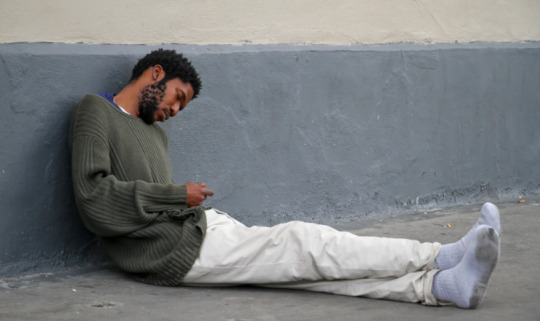
Not too many people do what Luther Keith does. Keith walks the streets among the homeless, passing out clothes and serving the unhoused with hot meals. This has been an everyday occurrence for Keith for over two decades.
On a weekly basis, Keith donates his time and feeds hundreds, sometimes thousands.
“That was my mission back in 1999, [that’s] to feed the homeless,” said Keith. “I started doing this on Avalon and Imperial Highway back in 1999 when I was at Locke High [School].”
At the time of his calling to help out those on the streets, Keith was a security officer for Locke High School in an area previously known as Watts, which is now encompassed inside of the boundaries of South Los Angeles.
A longtime gang interventionist, Keith has a strong presence on the streets of South Los Angeles. Working as the head of security for the renowned Drew League, a pro-am summer basketball league that has become home in the offseason for many NBA players, and keeping the peace among warring gang factions, Keith is a doer and not a talker when it comes to helping others.
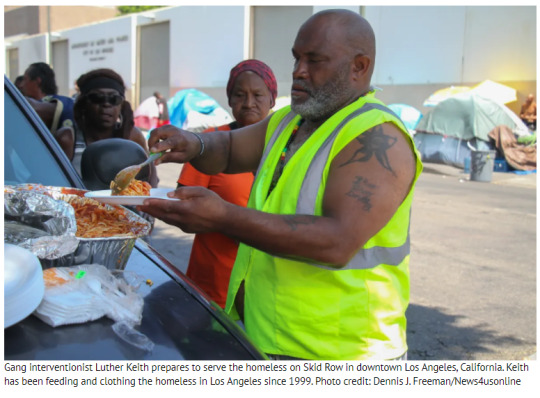
Feeding and clothing the homeless is not for the faint of heart. Driving through downtown Los Angeles one can encounter many things. First, the many skyscrapers silhouettes that outline the Southern California skies make for a breathtaking view.
There are local hotspots and eateries that pop up on just about every block of the downtown area that make it chic or trendy to wine and dine.
STAPLES Center, the place that the Los Angeles Lakers and Los Angeles Clippers call home, is snuggled in the midst of all of this hustle and bustle. Right across the street sits the Microsoft Theater, where live concerts from some of the biggest names in the music and entertainment industries are constantly on display as artists come and pay a visit when they’re in town performing.
Then there is Skid Row which is the direct antithesis to everything that is glamorous and modern in the downtown area of the second-largest city in America.
Though it is located in the downtown area of Los Angeles, a person would have to go through nearly two miles of designated parking lots and clumps of buildings and go past the city’s Los Angeles Fashion District before encountering humanity at its worse.
Skid Row is a proliferation of tents, gangs, hustlers, prostitution, gambling, and drug activity. The streets are blackened by the large amounts of trash and debris that have settled on them. The air space is almost inhalable. Assaults and robberies can happen about as quickly as you snap your fingers.
Navigating through Skid Row and other parts of downtown Los Angeles can be a dangerous place to walk or drive. The Covid-19 pandemic has magnified the danger alert to an even greater level. Keith is not too concerned about it. That’s because as a devout Christian, Keith arms himself with the faith weapons he’s been given on his sleeves.
These are the antidotes to any negativity he may encounter when he’s out and about doing what he’s called to do.
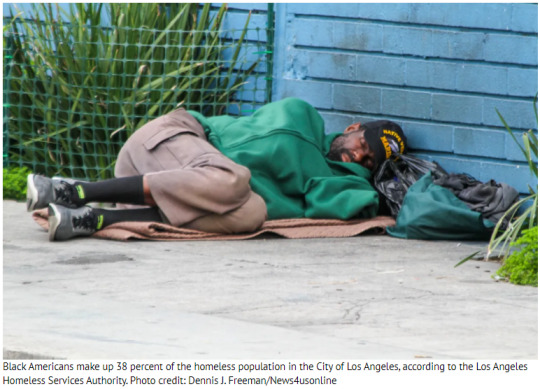
Judge David O. Carter gave the elected officials representing the City Los Angeles and Los Angeles County a sharp rebuke for failing to properly address the homeless crisis. The judge issued a memo ordering those living on Skid Row to be housed by this fall.
“There can be no defense to the indefensible,” Carter wrote in a 110-page ruling in the court case LA Alliance for Human Rights v City of Los Angeles. “For all the declarations of success that we are fed, citizens themselves see the heartbreaking misery of the homeless and the degradation of their City and County. Los Angeles has lost its parks, beaches, schools, sidewalks, and highway systems due to the inaction of City and County officials who have left our homeless citizens with no other place to turn. All of the rhetoric, promises, plans, and budgeting cannot obscure the shameful reality of this crisis—that year after year, there are more homeless Angelenos, and year after year, more homeless Angelenos die on the streets.”
The system of homelessness has become a Black problem with long-rooted institutional checks and balances in place playing a significant role behind the scenes, said Heidi Marston, director of the Los Angeles Homeless Services Authority.
“I want to be very clear, homelessness is a byproduct of racism,” Marston said. “We continue to see that Black people are overrepresented in our homeless population and that Black African Americans are four times more likely to become homeless than their white counterparts.”
Being homeless and Black in the middle of the Covid-19 is not just a Los Angeles thing. The numbers are just as staggering nationally. Much like the population-to-homeless ratio in Los Angeles, unhoused statistics for Blacks across the country are alarming.
According to the 2020 Annual Homeless Assessment Report (AHAR) to Congress, a report backed by the U.S. Department of Housing and Urban Development, 39 percent of the people who are homeless nationwide are Black. The AHAR report, released this past January, also concluded that Blacks with families and children (53 percent) are in far greater numbers to be homeless than any other ethnic group surveyed.
According to a 2020 U.S. Census study, Blacks are just 12 percent of the general population in the country, a sobering reality to the vast homelessness numbers this group represents. There are several contributing factors as to why many Black people can be found on the streets or are unsheltered, according to the National Alliance to End Homelessness.
The main causes, poverty, rental and housing discrimination, lack of access to quality health care and incarceration, are nothing new. When it comes to re-entering back into society after being incarcerated, Black women are more likely than anyone else to be homeless, according to the Prison Policy Initiative. That’s including Black men.
A New Way of Life Reentry Project, founded by Susan Burton, does its best to address the needs of these women once they leave jail or prison.
“A New Way of Life and similar programs offer people released from jails and prisons an opportunity to live in a safe, welcoming, structured, and supportive environment where both staff and other residents understand the challenges that convicted and formerly incarcerated people face, and are able to offer a clear path forward,” said Pamela Marshall, co-director of A New Way of Life Reentry Project.
“Having stable, safe and affordable housing improves an individuals’ abilities to reduce stress; to heal from trauma or addiction; to manage a health or mental health condition; to find and maintain employment; to protect, uplift and support children and other family members; to attend school and/or job training programs; to avoid violence and system contact,” Marshall added.
Based in South Los Angeles, A New Way of Life Reentry Project has 10 homes to accommodate women coming from jail or prison. Marshall said once these individuals put incarceration in the rearview mirror, trying to live and function in normalcy, can be overwhelming.
“Imagine living in a jail or prison cell where your every movement, every minute, every meal and every decision has been made for you and you are suddenly released with $200 or less, without a state ID, social security card, medical or birth documents, into a world where the technology, bus routes, culture, and communities have advanced far into the future leaving you without direction or understanding and you have also lost all contact with family, friends or a place to stay,” Marshall said.
While A New Way of Life Reentry Project has a more structural way of helping those once locked up to stay off the streets, Keith keeps things pushing with his charitable outreach, bringing encouragement and food to fill the bellies and minds of the homeless. And he does it without fear.
“If you ain’t equipped and know how to do this…they got gangs down there,” Keith said. “Folks are scared to go down there.”

1 note
·
View note
Link
"In 1910, the last year of his life and only a few years before World War I put an end to the long European peace, William James wrote a pamphlet for the Association for International Conciliation, one of the many pacifist groups whose prominence in that period convinced many people that war between nations, being so obviously irrational, was therefore impossible. James’s essay, titled “The Moral Equivalent of War,” is a work of supreme pathos and wisdom. James himself was a pacifist, a founding member of the Anti-Imperialist League, a group formed to protest America’s military interventions in Cuba, Haiti, and the Philippines, and one of the most humane and generous spirits America or any other nation has ever produced.
James understood perfectly the folly—the “monstrosity,” as he called it—of war, even in those comparatively innocent, pre-nuclear days. But he also acknowledged the place of the martial virtues in a healthy character. “We inherit the warlike type,” he pointed out, “and for most of the capacities of heroism that the human race is full of we have to thank [our bloody] history.” “The martial virtues,” he continued, “although originally gained by the race through war, are absolute and permanent human goods.... Militarism is the supreme theater of strenuousness, the great preserver of our ideals of hardihood; and human life with no use for strenuousness and hardihood would be contemptible.” “We pacifists,” he wrote with characteristic intellectual generosity, “ought to enter more deeply into the aesthetic and ethical point of view of our opponents.” To militarists, a world without war is “a sheep’s paradise,” flat and insipid. “No scorn, no hardness, no valor any more!” he imagines them saying indignantly. “Fie upon such a cattleyard of a planet!” This, remember, was the era of Teddy Roosevelt, preacher of the strenuous life and instigator of splendid little wars. James’s pacifism may be common sense to you and me, but when he wrote, the common sense of Americans was mostly on Roosevelt’s side.
How to nourish the martial virtues without war? James resolved this apparent dilemma with a suggestion many decades ahead of its time: universal national service, every youth to be conscripted for several years of hard and socially necessary physical work, with no exceptions and no class or educational discrimination. This army without weapons would be the moral equivalent of war, breeding, James argued, some of the virtues essential to democracy: “intrepidity, contempt of softness, surrender of private interest, obedience to command.” I am sure James would have agreed that these are not the only virtues essential to democracy—he himself, with his anti-imperialist activism, exemplified an equally essential skepticism and resistance to authority. But I wonder if our contemporaries, who mostly need no convincing about the necessity of skepticism and resistance to authority, would also agree with James about the importance of valor, strenuousness, and self-sacrifice.
James wrote in America before World War I, a situation of almost idyllic innocence compared with that of the next writer I want to cite, D. H. Lawrence. The Great War, as contemporaries called it, was a soul-shattering experience for English writers. The complacent stupidity with which Europe’s governing classes initiated, conducted, and concluded that war, the chauvinism and bloodlust with which ordinary people welcomed it, and above all, the mindless, mechanical grinding up of millions of lives by a war machine that seemed to go of itself—these things infuriated Lawrence almost to madness. Like many others, Lawrence saw the facelessness, the impersonality, the almost bureaucratic character of this mass violence as something new and horrifying in human history. But more than all others in the twentieth century, Lawrence was the champion of the body and the instincts against the abstract, impersonal forces of modernity. Like Nietzsche, he marshaled torrents of impassioned prose against the apparently inexorable encroachments of progress. Here is a passage from “Education of the People,” published posthumously in the two volumes of Phoenix.
We are all fighters. Let us fight. Has it come down to chasing a poor fox and kicking a leather ball? Heavens, what a spectacle we should be to the ancient Greek. Rouse the old male spirit again. The male is always a fighter. The human male is a superb and god-like fighter, unless he is contravened in his own nature. In fighting to the death, he has one great crisis of his being.
What is the fight? It is a primary, physical thing. It is not a horrible, obscene, abstract business, like our last war. It is not a ghastly and blasphemous translation of ideas into engines, and men into cannon-fodder. Away with such war. A million times away with such obscenity. Let the desire of it die out of mankind.... Let us beat our plowshares into swords, if we will. But let us blow all guns and explosives and poison-gases sky-high. Let us shoot every man who makes one more grain of gunpowder, with his own powder.
And then let us be soldiers, hand-to-hand soldiers. Lord, but it is a bitter thing to be born at the end of a rotten, idea-ridden machine civilization. Think what we’ve missed: the glorious bright passion of anger and pride, reckless and dauntless.
(...)
Modernity imperils another set of virtues, which are a little harder to characterize than the martial virtues, but are even more important. I don’t mean the bourgeois virtues, though there’s some overlap. I suppose I’d call them the yeoman virtues. I have in mind the qualities we associate with life in the early American republic—the positive qualities, of course, not the qualities that enabled slavery and genocide. In 1820, 80 percent of the American population was self-employed. Protestant Christianity, local self-government, and agrarian and artisanal producerism fostered a culture of self-control, self-reliance, integrity, diligence, and neighborliness—the American ethos that Tocqueville praised and that Lincoln argued was incompatible with large-scale slave-owning. Today that ethos survives only in political speeches and Hollywood movies. In a society based on precarious employment and feverish consumption, on debt, financial trickery, endless manipulation, and incessant distraction, such a sensibility seems archaic.
According to the late Christopher Lasch, the advent of mass production and the new relations of authority it introduced in every sphere of social life wrought a fateful change in the prevailing American character. Psychological maturation—as Lasch, relying on Freud, explicated it—depended crucially on face-to-face relations, on a rhythm and a scale that industrialism disrupted. The result was a weakened, malleable self, more easily regimented than its pre-industrial forebear, less able to withstand conformist pressures and bureaucratic manipulation—the antithesis of the rugged individualism that had undergirded the republican virtues.In an important recent book, The Age of Acquiescence, the historian Steve Fraser deploys a similar argument to explain why, in contrast with the first Gilded Age, when America was wracked by furious anti-capitalist resistance, popular response in our time to the depredations of capitalism has been so feeble. Here is Fraser’s thesis:
During the first Gilded Age the work ethic constituted the nuclear core of American cultural belief and practice. That era’s emphasis on capital accumulation presumed frugality, saving, and delayed gratification as well as disciplined, methodical labor. That ethos frowned on self-indulgence, was wary of debt, denounced wealth not transparently connected to useful, tangible outputs, and feared libidinal excess, whether that took the form of gambling, sumptuary displays, leisured indolence, or uninhibited sexuality.
How at odds that all is with the moral and psychic economy of our own second Gilded Age. An economy kept aloft by finance and mass consumption has for a long time rested on an ethos of immediate gratification, enjoyed a love affair with debt, speculation, and risk, erased the distinction between productive labor and pursuits once upon a time judged parasitic, and become endlessly inventive about ways to supercharge with libido even the homeliest of household wares.
Can these two diverging political economies—one resting on industry, the other on finance—and these two polarized sensibilities—one fearing God, the other living in an impromptu moment to moment—explain the Great Noise of the first Gilded Age and the Great Silence of the second? Is it possible that people still attached by custom and belief to ways of subsisting that had originated outside the orbit of capital accumulation were for that very reason both psychologically and politically more existentially desperate, more capable, and more audacious in envisioning a non-capitalist future than those who have come of age knowing nothing else?
If this argument is true—and I find it painfully plausible—where does that leave us? An individual’s or a society’s character cannot be willed into or out of existence. Lost virtues and solidarities cannot be regained overnight, or even, perhaps, in a generation. Even our ideologies of liberation may have to be rethought. A transvaluation of values may be in order: faster, easier, and more may have to give way to slower, harder, and less—not only for ecological reasons but also for reasons of mental and moral hygiene. And even if we decide, as a society, to spit out the poisoned apple of consumerism and technological addiction, is there a path back—or forward, for that matter? If individual self-sufficiency and local self-government are prerequisites for human flourishing, then maybe it is too late.
(...)
Do my apparently disparate-sounding worries have anything in common? Possibly this: they all result from one or another move on the part of the culture away from the immediate, the instinctual, the face-to-face. We are embodied beings, gradually adapted over millions of years to thrive on a certain scale, our metabolisms a delicate orchestration of innumerable biological and geophysical rhythms. The culture of modernity has thrust upon us, sometimes with traumatic abruptness, experiences, relationships, and powers for which we may not yet be ready—to which we may need more time to adapt.
But time is short. “All that is solid melts into air”—Marx meant the crust of tradition, dissolving in the acid bath of global capitalism. Now, however, the earth itself is melting. Marx’s great metaphor has acquired a terrifying second meaning."And so has Nietzsche’s. If we cannot slow down and grow cautiously, evenly, gradually into our new technological and political possibilities and responsibilities—even the potentially liberating ones—the last recognizably individual men and women may give place, before too many more generations, to the simultaneously sub- and super-human civilization of the hive."
2 notes
·
View notes
Text
Euphorically Honest-- Euphoria, Teenagers, and the Realities in Hardship
OVERVIEW
Euphoria is brutally honest about the hardships of life. Focusing on the stories of a group of teenagers in modern-day California, it navigates through issues of drug addiction, sexuality, masculinity and femininity, violence, and depression. It can be tragic and liberating. But it is honest. Created by Sam Levinson, a screenwriter for Assassination Nation and The Wizard of Lies, the story reflects on his own experience with drug addiction as a teenager, as well as having a loose basis in an Israeli show of the same name (Stack, 2019). The story follows a group of young people of varying genders, ethnicities, classes, and sexualities, including the drug-addicted narrator Rue, new-to-the-suburbs Jules, Cassie, beautiful but easily manipulated, her kind and easy-going sister Lexi, Kat, who embraces her body type as she gains confidence through sex, Nate, a manipulative and dominating male with control issues, and his girlfriend, Maddy, who battles her self-identity and her reliance on Nate (Levinson, 2019). Euphoria can be seen as overly graphic, or critiqued as too sexual, but its mature nature allows it to unearth the ugly truths about life, living, and loving, and the beauty behind the hardships too.
EPISODE TWO REVIEW
In “Stuntin Like My Daddy,” Nate discovers his father’s sex tape collection at a very young age, videos of his father having sex with several people. This is where Nate’s disdain male sexual anatomy stems from. Nate quickly becomes infatuated with Maddy. Whether disturbing or romantic, he fantasizes about hurting or killing the person who dares harms her. A series of flashbacks from Rue’s summer shows her consuming various drugs and getting high, fighting with her mom, waking up in the hospital, and singing in the car with her mom and sister, highlighting what she has gone through as well as her relationship with her family. On several occasions, Rue relapses. Reluctantly and unable to say no, she takes a dose of fentanyl. Unaware of the consequences, Jules is called to take care of Rue. Their friendship further develops. Kat learns that an explicit video of her has been posted to a porn website. When the video’s view count continues to grow, Kat is intrigued and signs for a web cam streaming account. Obsessed with Maddy, Nate begins stalking Tyler, Maddy’s most recent hookup. Maddy, still wanting to get back together with Nate, tells him that she was blacked out and did not mean to do what she did. This causes Nate to believe that Tyler had raped Maddy. Furious, Nate breaks into Tyler’s apartment and beats him half to death. At the end of the episode, we learn that the guy Jules has been texting is named Tyler but it actually turns out to be Nate.
Nate Jacobs is the typical football jock, yet he exhibits anger, aggression, and sociopathic behavior. Rue Bennett struggles with her own psyche as she suffers from ADHD, bipolar, general anxiety, BPD (borderline personality disorder), and drug addiction. Jules Vaughan is unapologetically herself, although she seems to seek attention, approval, and sexual relationships from men who are undeserving of her. Maddy Perez is the popular cheerleader who knows she is attractive and she goes after what she wants. She stands up to everybody else except Nate. Kat Hernandez may seem like a side character, the fat best friend, at first, but she finds her confidence grows as an individual. Fez/Fezco is Rue’s main drug dealer. Although he supplies her, he also cares for Rue and does want her to get mixed up with a worst crowd.
Although there are people of color in the show, there could always be more representation of race. Rue and her sister, Gia, are mixed, with a Black mom and a white dad. Maddy is Latina as both of her parents are Latino. Kat Hernandez is also of Latin descent but we do not see much of her parents or family. Every other (main) character in this episode is white, this includes Nate, Jules, and Tyler. This show, and episode, is not particularly making any waves or strides with their representation of race. And with the representation of race that they do have, there is no portrayal of racial identity, culture, or heritage. Jules definitely stands out as she is a transgender woman. She is currently taking hormones and her father and closest friends accept her for who she is. Jules goes on to have sexual encounters with older men as well budding romances with boys her age. Nate is a stark contrast to Jules, with him being set in his heteronormative, gender binary ways. Most, if not all of the characters identify with the gender that they present. The males, Nate and Fez identity as male. The females, Rue, Kat, Jules, and Maddy identify as female. The main characters mainly fall into one of the two binary genders. All of the romantic or sexual relationship aspects in episode 2 revolve around a male and a female, such as Nate and Maddy, or Maddy and Tyler, or even Jules and her mysterious texter (a man). To my knowledge, there is no presence of a non-binary or agender character. Jules, a transgender woman, challenges Nate’s notion of the strict gender binary system.
Euphoria definitely relies on stereotypes because the writers of this show intend on having the characters break said stereotypes. Kat is initially insecure and self-conscious. After she has sex for the first time and the video of the act gets leaked, she redefines herself. Her sexuality blossoms throughout this show as she also begins to have casual sex which normalizing women having and enjoying sex. Kat becomes comfortable with herself by wearing clothes that are considered more edgy, outfits that she would have never worn before. Kat’s character breaks the sexuality stereotype because the media hardly ever sees a plus-sized woman be expressed in a sexually positive light, even though it may not have started out that way. Nate’s character is embodiment of the toxic, cis-gendered white masculinity. He describes the perfect girl as dressing more feminine, acting like a “proper lady,” and overall more “girly” as opposed to “tomboy.” Because he is so uncomfortable with the male sexual anatomy, and even disturbed by how comfortable others are, he may have some issues regarding internal homophobia. Nate does not really defy this stereotype, his character is the epitome of this stereotype. Maddy, a cisgender, heterosexual female, understands the delicate nature of the gender constructed society. She has prioritized Nate and his needs sexually by watching porn in order to mimic what the porn actress does so that she can please Nate. Her sexuality is rarely mentioned, it only rises in conjunction with other boys. Jules’ character as a transgender person challenges the conventional gender roles and constructs. Jules is very comfortable with herself and her sexuality and is proud of who she is.The concept of a non-binary gender system perplexes many people. With the current administration, transgender rights are not protected. In fact, transgender people are continued to be discriminated against. The Trump administration has played a major role in “withdrawing regulatory protections for transgender children in schools, fought recognition of transgender people under federal employment laws, banned transgender people from serving in the military, rolled back protections for transgender people in prisons, and threatened to cut off funding to schools that let transgender girls participate in sports” (Thoreson). Although Jules is able to be who she want to be and live the life that she wants, this may not be the case for many transgender people in the real world outside of the show.
Today people are often quick to criminalize or shun drug users and addicts. They are quick to judge and want the most severe punishment to be given. But medical professionals know that addiction is a very serious disease, one that requires “treatment, compassion, and support” (Siegel). Euphoria attempts to destigmatize and humanize addiction. The legal system should not be punishing people who have abused drugs by putting them into a jail cell where they are isolated from society, instead these people need real help through rehab and various treatments. Due to the fact that Rue had several relapses once she completed her rehab program, one may say that these programs do not work; however there is no singular timeline to get better. It may take weeks, months, or years, and the journey is difficult. But society cannot give up. Social and political reforms concerning drug use/abuse and addiction is very much needed.
EPISODE THREE REVIEW
In ' Made You Look,' Nate meets Jules on a gay dating app disguised as Shyguy118. Although Nate doesn't identify as gay, Jules reveals being transexual and quickly falls in love with Shyguy118, oblivious to his true identity as a classmate at the same school. Maddy becomes skeptical of Nate and searches through his phone and, in shock, learns of Nate's involvement with a gay dating app and nude sending with Jules. Jules's heightened obsession over the mysterious Shyguy118 leads Jules to agree to meet Nate for the first time in person near a lake at night. While all of this unfolds, Rue, who is Jules's supportive best friend, at first, entertains Jules's fantasies by helping Jules send pornographic images to Nate. However, tension arises when Rue exposes her worries for her best friend and undeniable attraction for her as more than just friends. Unfortunately, Jules did not reciprocate the kiss they shared. This sent Rue spiraling into a frenzy and falling back into the addictive habit of taking pills and getting high, undoing Rue's 60-day clean streak. Embarrassed, Rue runs straight back to Fezco, her drug dealer, in hopes to illegally obtain more drugs to numb the humiliation she felt. Fortunately, Fezco doesn't give in to Rue and shuts the door on her, leaving Rue to look toward Ali, an omniscient man she met at a therapy gathering for drug users to seek guidance.
Kat, a Tumblr fanfiction queen, masks herself while exploring her curiosity for explicit content and webcam streaming. She exposes herself to lingerie and twerking on her account; she agrees to perform a private camera meet with a man who falls in love with Kat's powerful and sexual dominatrix persona. Originally insecure with her weight, Kat eventually learns to embrace her curves and dives into a new and unusual world of femdom. This episode also introduces Cassie. She displays as a bold, open-minded party girl that isn't phased by frat party endeavors. McKay, Cassie's crush, invites her to his frat-hazing event, and they both fall deeply in love with each other, foreshadowing potential problems to come from concupiscence for one another.
This episode involves various races but is primarily white-dominant. Cassie is blonde and white, represented as audacious and open-minded. Maddy is a cis-gender Latina and, in this episode, victimized by Nate, a white playboy who cheats on Maddy. Rue and her sister are a mix from a black mom and a white dad. Despite various races represented, this episode minimally illustrates heritage background and racial and cultural distinctiveness. There are very minimal cultural representations and race diversity besides the racially represented individuals such as Rue, Maddy, Kat, Ali, and Fezco. Although the film is predominantly white race influenced, there is still a general race narration awareness displayed in the show.
Sexuality representation is a flourishing topic within each episode in Euphoria. Arguably one of the most influential characters in this episode, Rue, a lesbian half black teenager, finds herself falling in love with her openly transgender best friend. This tricky love triangle is demonstrated between Rue caring for Jules while she cares for Nate. Jules is head over heels for her classmate, Nate, who hasn't announced is gay but is chatting with Jules on a gay dating site. Moreover, Nate's girlfriend in this episode, Maddy, is only now beginning to question if Nate is straight like he demands he is.This episode centers around redirecting the audience's view of how a character's sexuality is initially perceived to how each character's sexuality is either nonchanging or questioned and altered due to more self-awareness. For example, Jules, from the beginning, identified as transgender and unchanging while Rue begins to question her sexuality and feelings for her friend after kissing her. Male, female, and non-binary characters speak and act quite differently in Euphoria. Male actors such as Nate, Ali, and Fezco are very much dominant and slightly manipulative in this episode. Nate is a controlling and manipulative character fueled by curiosity and confusion. Ali is a mysterious, omniscient figure who sees past Rue's addiction. Lastly, Fezco shuts Rue out when she almost dies from the drugs he gave her. The females include Maddy, Rue, Jules, Kat, and Cassie. Non-binary characters were not present in this episode; however, Nate being on a gay dating site and taking an interest in Jules knowing her being transgender urges the question of what Nate's sexuality may be.
Cassie, in this episode, played an essential role in breaking gender profiling stereotypes. When Cassie was at the weekend frat-hazing party with McKay, she stood up to the guys at the party and took a shot of water with a live goldfish in it without hesitation, while McKay was hesitant and wanted to reject the challenge. Cassie taking that shot was significant because she didn't abide by her gender role limitations. Instead, she proved that she could equally compete alongside the frat boys at the party.
Illegal drug use for underage teenagers is very much a political issue. The creator of Euphoria, Sam Levinson, opens up about his struggles with addiction growing up. He talks about how his personal history of drug use as a teenager animated Rue's similar struggles in Euphoria. It's essential to recognize that Rue was not using drugs because of peer pressure but because she was struggling with "obsessive-compulsive disorder (OCD), attention deficit disorder (ADD), general anxiety disorder, and even bipolar disorder" (Health, 2020). Many teens go undiagnosed with disorders like these and spend their teenage years fighting addiction and going to rehab centers, sometimes more than once in hopes of ending the addiction. There are other situations where undiagnosed individuals who don't fall victim to drug addiction still live a life of struggle with their mental illness. Euphoria sheds light on addiction and mental health and de-stigmatizes mental illness, a topic that should be further normalized and empathized with.
EPISODE SEVEN REVIEW
“The Trials and Tribulations of Trying to Pee While Depressed” tackles a lot of issues. In many ways, this episode is openly candid about the hardships of life and the modern influences of distraction and avoidance. The candor of this episode is heartbreaking, revelating, and so, so real. The episode before the season finale follows multiple characters, including Jules, a trans woman battling confusion about her relationship with her best friend and her changing life; Cassie, a beautiful blonde teenager facing an unplanned pregnancy; and Rue, a drug addicted teenager battling a major low in her depression (Levinson 2019). This episode follows many differing plots that do not intersect in its time; however, at the root of the 59 minutes is the juxtaposition of two teenagers, the structures of family, and the deconstruction of femininity.
As a whole, this show is unapologetically divergent from the stereotypes of society. It does not hesitate to tackle hard issues, easily addresses controversial issues regarding race, sexuality, and gender, without negating their seriousness. It makes normal the darkness we all battle in our private lives, especially in this episode. In it, characters from all walks of life get a say in the plot. Not only is the narrator and main character a gay Black women in love with her best friend, we also follow the story of Jules, a trans women, and hear from Cassie, a straight cisgender blonde girl who falls victim to the confines of the patriarchy, allowing herself to be sexualized and invalidated as a possession by the men in her life (Johnson, 2014). My only criticisms regarding this episode’s diversity is that there is little male influence or perspective on the storyline, and further, that there is little diversity outside of “black and white.” That is to say, while there are many Black characters given voice to this episode (and, by default many white characters as well), there is little representation of other ethnicities. We do not hear, for example, from the perspective of an Asian-American. That, to some extent, is an area that can be improved as the show continues.
Earlier I mentioned the juxtaposition at the core of this episode, and I want to dive a little deeper into that. Cassie and Rue are, in many regards, polar opposites. Rue is Black, gay, struggles with drug addiction and is a social outcast. Cassie, in comparison, is blonde and blue eyed, gorgeous, and popular. Rue is an older sister; Cassie is the younger in her family. But this juxtaposition highlights the conditions of the patriarchy that define familial dynamics, such as sisterhood and motherhood, both amplifying and deconstructing those norms. For example, at the end of the episode, Rue and Cassie both go to their moms, the caretakers, for help when they reach rock bottom. Those mothers show up, and they do their job: care. However, at the same time, these mothers have taken up the role of being the breadwinner for the family as well, defying the stereotype of reliance on the male for prosperity and survival. Rue’s mom, however, is portrayed as more successful and put-together than Cassie’s mother, whom we see to be an alcoholic and basically a hot mess. This is contrary to racial stereotypes that typically portray the black community as one falling apart and the white suburban mom as picture-perfect. The gender and racial norms that society and time have produced throughout our history in America are blurred as these two realities are expressed in this show (Scott, 1986).
This episode also attacks femininity. Speaking with her friends from the city, Jules, says, “In my head, it’s like if I can conquer men, I can conquer femininity” (Levinson, 2019). This conquering, or, as Jules later says, obliteration of femininity is addressed throughout the episode. Cassie, conforming to societal expectations, allows herself to be objectified and sexualized by all the men in her life, using that perception of beauty to define her over the course of her life. Rue, on the other hand, does not conform to femininity at all, as we see in the way she dresses, and even the persona of the masculine “detective” she took on in a manic state. These three approaches to femininity contrast each other, as each one represents a different sector of diversity: race, sexuality, and gender identity.
Euphoria is inherently political. It brings to light the reasons why the personal is political, especially in the midst of an election cycle where the rights of those who don’t conform to societal norms are under threat. This show creates an avenue for those rights and the real people behind those laws to speak and tell their own stories. Not only that, it represents mental illness and drug abuse, revealing the realities of living with these issues and bringing to light the struggles of the individual and their community through addiction and mental health crises. The show helps create empathy; empathy creates connection. And connection, more than anything else, is something we deeply need right now.
CITATIONS
Euphoria creator Sam Levinson on his controversial show: 'I hope it opens up a dialogue' [Interview by T. Stack]. (2019, June 16). Entertainment Weekly. Retrieved 2020, from https://ew.com/tv/2019/06/16/euphoria-creator-sam-levinson/.
Health, A. (2020). How HBO’s ‘Euphoria’ Depicts Teenage Drug Addiction Accurately. Retrieved 14 November 2020, from https://amhealth.com/2019/09/25/how-hbos-euphoria-depicts-teenage-drug-addiction-accurately/
Johnson, A. G. (2020). Patriarchy, the System: An It, Not a He, a Them, or an Us. In 1046495481 799935172 G. Kirk & 1046495482 799935172 M. Okazawa-Rey (Authors), Gendered Lives: Intersectional Perspectives (Seventh ed., pp. 62-70). New York, New York: Oxford University Press. (The Gender Knot: Unraveling Our Patriarchal Legacy, (2014))
Levinson, S. (Writer). (2019). Euphoria [Television series]. HBO.
Levinson, S. (Writer). (2019, June 23). Stuntin’ Like My Daddy [Television series episode] In Euphoria. HBO.
Levinson, S. (Writer). (2019, July 28). The Trials and Tribulations of Trying to Pee While Depressed [Television series episode]. In Euphoria. HBO.
Scott, J. (1986). Gender: A Useful Category of Historical Analysis. The American Historical Review. doi:10.1086/ahr/91.5.1053
Siegel, Z. (2019, August 06). Euphoria Doesn't Have a Drug Problem. Retrieved November 12, 2020, from https://www.vulture.com/2019/08/euphoria-hbo-drug-addiction-overdose.html
12 notes
·
View notes
Text
TwitterBlazers
The Portland Trailblazers twitter community is made up of basketball fans, specifically those who love to support (or hate) the team. This demographic is largely men over the age of 25, and under the age of 55. Most of these users come from Oregon and Washington, but the community attracts interaction from users all over the world.
In my posts I aimed to attract attention through the current events that were going on in the NBA and Trailblazers. Specifically I reflected on Damian Lillard’s outstanding performance...
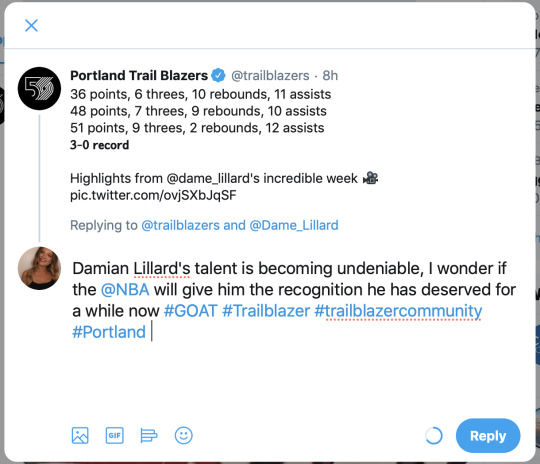
and the tragic passing of Kobe Bryant...
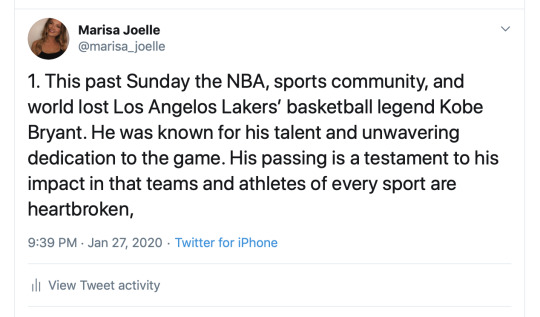
I was unsuccessful in receiving interaction on my account, but I was successful in learning a ton of information on the who/ what’s/ and why’s behind successful twitter activity.
Twitter is governed by pure chaos, which makes the platform addicting. Not only are common users attracted to the unpredictability of twitter, news outlets and corporations join in on these trends as well. The benefit of the unpredictability of twitter is that anyone can involve themselves by providing a unique or interesting take on current events. Businesses and marketers have observed spike in attention that comes with viral content, and have learned to produce content that capitalizes on viral trends as fast as possible. Sports play a large role in this because sports moments are commonly tokens of viral content, even captivating the attention of people who don’t care for sports.
There are strategic steps that users take to capitalize on the face pace, viral nature of twitter. As fast as content on twitter is born, it dies off. With the nature of twitter being so fast paced, nothing on the platform is constant. One tweet, meme, or article will have its time in the spotlight, and twitter is quick to dissect every inch of it before tossing it into the pile of all the other over-shared memes. This means that those on the app need to be attentive, reactive, and insightful. Paying attention to twitter activity and popular trends is crucial to get on top of the attraction that they bring. Next comes being reactive; this means to know exactly how to respond in a way that will gain even more attention than the original content. Finally, being insightful; this can be done through unique takes, controversial opinions, or complementary information.
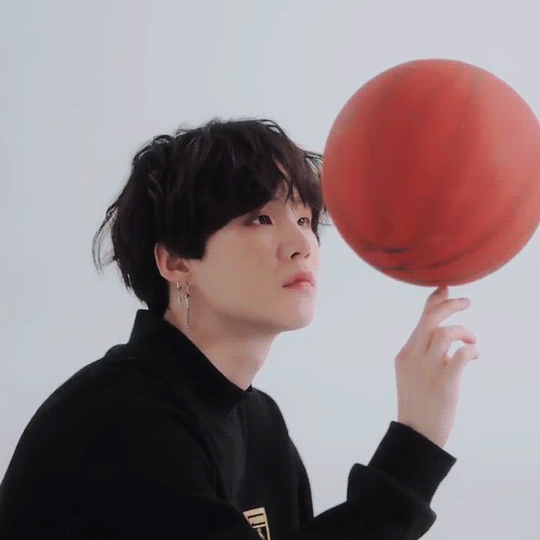
What drives the viral nature of twitter?
The twitter user social media group values quick, information, and interesting information and perspectives. This is a network that does not want to spend a lot of time reading and digesting information; they want their information concise and clear. To attract attention and responses on twitter it is crucial to use information that is controversial, and will stir up opinions from multiple viewpoints. Those who have mastered the ability to provoke interest on twitter will have endless replies to their tweets that are filled with responses, corrections, or contradictions to their content.
The Portland Trailblazer community specifically loves to agree about the physical ability and talents of the players on the Blazers and opposing teams. Further, this community will react to the outside lives, clothing, and behavior of the players, even though none of these aspects have to do with basketball.
The goal of this community is to share the various opinions, perspectives, and responses to current events and topics. Twitter is full of comedy, personal posts, and meaningless pieces of information, but content that is shared the most reflects on the events that are taking place in the world. With all news stations, media outlets, and corporations being on twitter, people no longer turn on the TV to find the news. Local, national, and international news is updated and regurgitated faster than ever through twitter, shortening the attention span of everyone on social media.
This community loves to come together to celebrate the victories of the team. Some of the most notable twitter moments have surrounded the star player Damian Lillard. Damian is known to sink three point shots - most famously during crunch time. One of the most notable moments in the Trailblazer twitter community was when Damian made a three point buzzer beater, from nearly half court. Not only did his shot win the Trailblazers the game against Oklahoma, it won them the series, advancing the team to the Western Conference Semifinals, amazing right? Not exactly. In true twitter fashion, fans from both the team and opposing teams came together to argue that the shot was “too risky” and he had gotten “lucky”. This stirred the entire twitter network, causing tweeters and professional alike to argue both sides of the game winning shot. However, negativity was not the main response to this sports moment. The official Trailblazer account, ESPN, Complex, GQ and other major media outlets tweeted out videos of this shot, using various songs, speeds, and angles to emphasize this outstanding moment.

This moment is a prime illustration of the purpose that users have given twitters. The days of waiting for the morning paper to read professional analys are over. Twitter has made it so that as soon as something noteworthy happens, the internet has seen it, eaten it up, and spit it out with the opinions from every angle.

The unspoken rules of twitter, that people have caught on to, are to seek out and expose any users that are spreading offensive or oppressive messages. This is important to recognize because it is a form of regulation for the chaos that takes place on twitter. While the speed and content of twitter is fast and unpredictable, the general unspoken rule is that users should be accepting of all types of people. Gender, race, orientation and other differentiating factors should not be used as means for bringing people down, and users regulate this internally. If people are found to be discriminating, twitter users are quick to go viral by exposing them.
So how did my twitter experience unfold?
Unfortunately my twitter account gained almost no attention, and I am not surprised. Most users who attract conversation through their large, established following. People are much more inclined to take part in a conversation with a person that has a large following, because it will attract more attention. Unless the user is sharing something extremely unique, interesting, or controversial, not many people will engage with a twitter user that does not have many followers.
The twitter community loves to feed off of users with large followings. These interactions can be both positive and negative, regardless, people share their opinions and feedback with popular twitter users. By not having the following, or particularly controversial opinions, I was not able to gain much traction on my account. If this assignment was over a longer period of time, and required more interaction, I may have been more successful in getting more responses on my posts.
Through the posts, and observing others, I noticed that the people who go “viral” are usually first to have a good take on an event or headline. Finding the generally, popular - unpopular opinion is another great way to gain attention. By this I mean that twitter uses will commonly state something that might be deemed an “unpopular opinion”, but ends up being agreed upon by lots of users.
Another way that I could have been more successful is by being super interactive. Tweeting daily, or multiple times daily, tagging and responding to other accounts, and following lots of accounts would have created more momentum on my profile. Further, I could have leveraged the fact that I am a girl getting involved in a community that is majority men. This would have helped my content because it would allow me to provide a perspective that is not as frequently shared in sports discussions.
Getting involved in this community during the NBA Playoffs is another great way to receive more interaction. During this time of the year the twitter community is extremely interactive because users are heavily invested in the outcome of the seasons. Many more users spend time on twitter looking at game results, predictions, and feedback on teams and players.
Overall, I was not successful in gaining interaction on my account, but I was successful in learning the patterns of the NBA community on twitter. Going forward I can leverage my knowledge in professional and personal settings. I can also use the information I gained from observing the twitter community in my Business Major, because it is a great way for tracking the behavior of twitter users. This can be leveraged to know when to purchase ad space, who to target these ads to, and what content to put on these ads.
https://www.gq.com/story/damian-lillard-buzzer-beater
https://www.complex.com/sports/2019/04/damian-lillard-game-winner-against-thunder-memes
1 note
·
View note
Text
Revisiting Buffy the Vampire Slayer : Intersectional Feminism in 2019
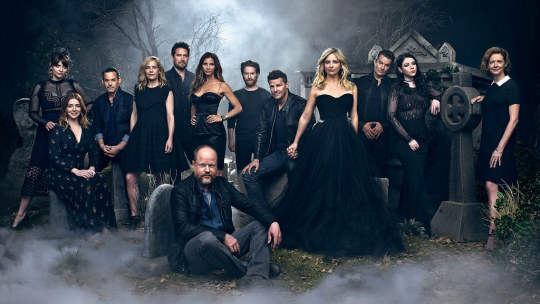
By Allison Hoag
Over twenty years after the series first premiered, Buffy the Vampire Slayer remains not only as a popular show in the public consciousness, but also as a hotly debated text in the academic sphere. What exactly is it about this demon-fighting, vampire-slaying, teenage girl that has captivated audiences for so long, and why has Buffy spawned so much controversy both publicly and academically? Most importantly, how should Buffy and its various implications about gender, race, and “otherness” be read in 2019?
It is undeniable that Buffy is a somewhat exclusionary narrative that directs our sympathies solely towards its overwhelmingly white and privileged characters. Any feminist inclinations this series espouses are emblematic of the equally exclusionary white feminism. However, even within these constraints—focusing only on feminism impactful to socioeconomically privileged white women—Buffy scholarship continually debates the extent of feminist messaging in the series. In 2019, surface-level white feminism alone is often not seen as enough to define a text as feminist. More and more, people are embracing Kimberle Crenshaw’s notions of intersectionality as a lens through which to evaluate texts. Crenshaw suggested that both feminist and anti-racist movements exclude black women, who face the most discrimination because of the intersection of their race and gender, arguing that “feminism must include an analysis of race if it hopes to express the aspirations of non-white women” (166). This term has since expanded to include class, ability, gender identity, and sexuality in feminist critiques.
Recently, the feminist debate over Buffy has been revisited after a somewhat shocking blog post by Buffy creator Joss Whedon’s ex-wife, Kai Cole, that suggested Whedon is not the “loveable geek-feminist” he presents himself as (Cole). Despite the flaws of its creator, is there still a way for Buffy to be viewed as a feminist show? Is this a matter of separating the artist from the art, or, because his intentions while making this art are being called into question, are the two inextricably linked? In light of these revelations, I intend to reexamine Buffy through Crenshaw’s intersectional lens, focusing less on surface-level feminist readings of this series, but instead shifting the focus onto specific storylines to explore how Whedon addresses topics of gender, race, love, and rape.
***
It is not without reason that critics and fans alike have showered Buffy with feminist praise since its debut in 1997. Not only does this series make Buffy the “subject of traditionally masculine storytelling tropes…, [but] she does it all as a tiny, blonde former cheerleader…the embodiment of the girl her genre usually kills first” (Grady). Buffy takes the idea of a “strong” woman quite literally and manifests a teenage girl with superhuman strength who “must stand against the vampires, demons, and forces of darkness,” as the introduction to each episode reminds us (Whedon). Buffy seems to be a show rife with positive female role models for the impressionable teen and pre-teen girls that make up its audience: Buffy is selfless and strong (physically and emotionally); Willow is kind, intelligent, and stands up for what she believes is right; Cordelia is bold and unafraid to go after what she wants; Tara is loving and is constantly helping and caring for her friends.
Buffy often addresses topics that many members of this teen audience may face, largely through its (sometimes heavy handed) metaphorical use of vampires and demons, as well as online predators (“I Robot…You, Jane”), drinking at parties (“Beer Bad”), and drug addiction (“Wrecked”). Seemingly less metaphorical, however, is its feminism. Throughout the series, Buffy repeatedly defends the whole of humanity against vampires, demons, and the like, maintains positive relationships with the other women in her life, is independent, and has (mostly) healthy romantic relationships. The overt “girl-power” theme of this show is quite clear. However, in its final season, Buffy “raises the explicit feminist stakes of the series considerably” (Pender). While in previous seasons, the metaphorical misogyny of the villains Buffy faces could be debated, season seven’s “big bad” is, “of all the show’s myriad manifestations of evil, the most recognizably misogynist” (Pender). Dubbed “Reverend-I-Hate-Women” by Xander (“Touched”), Caleb can only be defeated if Buffy teams up with and shares her power with all potential Slayers across the globe, an act that takes “female empowerment” quite literally in the series finale.
But how did Buffy get to this point? Buffy wasn’t even initially intended for the pre-teen and teenage girl demographic who would become its main audience. Knowing that this show was originally aimed at a male demographic, “it seems evident that producers did not intend to market a feminist show” (Riordan 292). Not only do some of the feminist statements in Buffy feel painfully forced, but upon deeper exploration, much of this show’s “feminism” is only surface-level and disregards Crenshaw’s notions of intersectionality.
Mary Magoulick, a folklorist and Professor of English, Interdisciplinary Studies, and Women’s Studies at Georgia College (“Mary Magoulick”), explores some of the downfalls of “feminist” shows that were primarily created by men for predominantly male audiences in her article, “Frustrating Female Heroism: Mixed Messages in Xena, Nikita, and Buffy.” Magoulick argues that female heroes like Buffy that are “conceived of and written mostly by men in a still male-dominated world…project the status quo more than they fulfill feminist hopes” (729). An integral part of Magoulick’s argument is the idea that “Buffy [is] less concerned with building or celebrating a world than surviving a hostile one” (745). Although Magoulick acknowledges that recognizing the hostility women face in the world is an important part of feminist conversations, Buffy is widely praised for its progressive presentation of women, not for “presenting the troubling reality women live in” (750). Buffy continually expresses her desire to escape from her responsibilities as the Slayer and lead an average life; yet, she continues fighting vampires and demons, largely due to the pressure from her Watcher, Giles. The idea that Buffy cannot escape her situation because of a social institution—the Watcher’s Council, dominated by men and put in place to control women—provides strong textual support for Magoulick’s claim that Buffy is “reflective of current social inequities and gender roles” (750).
Ultimately Buffy escapes her duties as Slayer, sacrificing herself in the season five finale, only for her friends to later resurrect her, bringing her back from what they believe to be a hell dimension. However, Buffy confesses to Spike, “I think I was in heaven. And now I'm not…this is hell” (“After Life”), making him promise to never tell her friends. After coming back to life, Buffy almost immediately returns to her predetermined social position and initially deals with being brought back into her personal version of hell alone, wanting to protect her friends from the truth. Not only does this arc present the feminist concept of emotional labor as something inherently expected of women, but it also more directly begs the question Magoulick poses regarding the entirety of the series: “Is survival in hell, albeit with occasional victories and humor, the best [women] can imagine?” (748).
***
Magoulick promotes an argument first raised by Elyce Rae Helford that “[Buffy] is laudable for allowing women unusual space to voice and act out anger” while also sending strong implications about what kind of women are allowed to express anger (733). Of the Slayers introduced throughout the series, Buffy is the only one who is allowed to act upon her anger, and most of the time this anger is expressed towards the vampires and demons she fights, not people in her personal life. However, Kendra—a Slayer who is also a woman of color—has her anger framed in a much more negative way. Despite the lack of people of color in Buffy—or possibly because of the show’s few characters played by people of color—race and racism have become prominent topics in Buffy scholarship. A closer examination of direct and indirect racist implications in Buffy reinforces the idea that any feminist tendencies in Buffy fall strictly into the category of white feminism, and the show cannot be considered an example of the intersectional feminism pushed for in 2019.
The intersectional failings of Buffy are further explored by Kent A. Ono, a Professor and former Chair of the Department of Communication at the University of Utah who researches representations of race, gender, sexuality, class, and nation in print, film, and television media (“Kent A. Ono”). In his article, “To Be a Vampire on Buffy the Vampire Slayer: Race and (‘Other’) Socially Marginalizing Positions on Horror TV,” Ono argues that Buffy “conveys debilitating images of and ideas about people of color” (163), claiming that “the valorization and heroification [sic] of a white feminist protagonist is constructed through an associated villainization and demonization of people of color” (164). Here, Ono quite literally means demonization. Most of the vampires and demons that appear on this show are played by white actors, so it is not necessarily a question of casting people of color as villains, so much as it is a question of who these villains are intended to be.
As previously established, the writers of Buffy can be somewhat aggressive with their use of metaphor; therefore, it is inarguable that, on Buffy, a vampire isn’t just a vampire. Ono argues that “the marginalization of vampires on the show takes the place of racial marginalization in the world outside the show” (172). In contrast, Magoulick presents a non-racial reading of the teenage vampires as “representative of gangs” (745). Considering the show’s overarching plot, especially the first few seasons Magoulick references when Buffy is still in high school, both of these interpretations are equally valid, and both can be supported by textual evidence. Given the history of representation of people of color on television, it is particularly disturbing that two of the major metaphorical interpretations of vampires on this show are as people of color and as gang members. It is not unreasonable to believe that Whedon and his writers were familiar with racist representations on television that were prominent in the 60s and early 70s, especially because some of these representations still exist twenty years after the show was created. With this understanding, it could be argued that vampires were equally intended to represent people who were racially marginalized and gangs. Ono argues that because the villains of Buffy were the ones chosen to represent people of color, “Buffy…indirectly and directly shows violence by primarily white vigilante youths against people of color in the name of civilization” (168), evoking images of violent white supremacy that are present throughout American history and to the present day.
However, there is a reason Ono describes the “vigilante youths” as only primarily white (168). Kendra, the previously mentioned second Slayer portrayed by Bianca Lawson who is featured in three episodes over the course of Buffy’s second season, is a black woman. Although only appearing in three episodes, Kendra is credited as “offer[ing] the most complex development of a black female character in Buffy” (Edwards 95). While this is technically true, it is important to note that her arc was fairly straightforward, and any character development is as a result of a somewhat racist narrative of acceptance only after assimilation. However, because she is one of the few examples of a prominent character who is a person of color and essentially the only person of color who works with Buffy, I will be examining her in some detail.
Ono argues that because she takes the responsibility of being the Slayer far more seriously, Kendra is a threat to Buffy, causing Buffy’s own racism to emerge. Ono specifically cites “[Buffy’s] discomfort with Kendra’s language…When Buffy uses the word wiggy and Kendra asks what that means, Buffy responds with a racist comment…‘You know, no kicko, no fighto’” (174). However, Buffy’s comment is indicative of a much larger issue in the show’s production team. “By casting Bianca Lawson, a black actress, in the role of Kendra, the second Slayer, [Whedon] makes character a sign imbued with cultural meanings about gender, race, and race relations” (Edwards 87). Kendra is marked as other not only by her skin color, but also by her heavy Jamaican accent, and she is not accepted by Buffy and her friends until she begins to assimilate, sending the message that people of color are responsible for changing themselves if they want to be accepted by white America.
It is important to note that Bianca Lawson’s casting wasn’t accidental. The script specifically delineates Kendra as an “ethnic young woman” (Edwards 91). Whedon has admitted that he did not make any efforts to hire people of color behind the scenes (Busis), so there is a possibility that the overwhelmingly white writers’ room and crew did not detect the racist treatment of Kendra. However, that in itself poses a major issue, not only socially, but also with how we’re supposed to understand the treatment of the few people of color and the metaphorical “people of color”/vampires throughout the series. The absence of people of color behind the scenes could also at least partially account for the Ono’s observation that “no person of color acknowledged as such on the series has been able to remain a significant character. All characters of color…have either died or have failed to reappear” (177).
Although she was killed off after only three episodes, as a black woman, Kendra represents the black women facing discrimination based on both race and gender that Crenshaw advocated for in developing her theory of intersectional feminism. Kendra’s treatment in Buffy is indicative of both the white feminism that will often ignore racist representations in a text because of its slight feminist messaging, and the necessity of including intersectionality in the evaluation and creation of feminist texts.
***
Buffy is filled with incredibly disturbing scenes. We watch Willow get skinned alive by a demon (“Same Time, Same Place”), Buffy’s own mother attempt to burn her at the stake (“Gingerbread”), and a demon stalk and murder sickly children in their hospital beds (“Killed by Death”). However, “Seeing Red” (2002) remains one of Buffy’s most upsetting episodes. Spike corners an injured Buffy in her bathroom and violently attempts to rape her until she is finally able to fight him off. In a recent interview, James Marsters (Spike) described his opposition to the scene, inadvertently pinpointing the reason this scene is so difficult to watch: “My argument was that, actually, when anyone is watching Buffy, they are Buffy…the audience, especially the female audience, they are not superheroes, but they are Buffy” (Marsters). This scene is particularly upsetting not only because of the content, but also because it presents many women’s worst fears—if an injured Buffy, who is still exponentially stronger than an average woman, can barely fight off Spike, what hope do they have of fighting off their attacker? Additionally, Spike is not presented as a violent vampire here: he is presented as human, making this scene more realistic and horrifying.
Wendy Fall, a doctoral candidate at Marquette University and editor of Marquette’s Gothic Archive (“Graduate Research”), discusses this scene at length in her article “Spike Is Forgiven: The Sympathetic Vampire's Resonance with Rape Culture.” She suggests that because James Malcolm Rymer’s Varney the Vampire (1845) is the first English-language vampire narrative that conflates an attack and rape scene, it established a “three-part strategy [gaslighting, silencing the victim, and emphasizing the assailant’s goodness] which encouraged readers to overlook Varney’s sexual violence, and thereby increased their sympathy for him” (Fall 76). She argues that although Spike’s attempted rape technically avoids Rymer’s narrative because he does not attempt to bite Buffy and is never even seen as a vampire, “The more problematic nature of this attack…is in what happens next, when the show adopts similar narrative schemes to Rymer’s to reinforce sympathy for Spike after his attempted sexual assault” (Fall 76).
Fall points out that there are only three more episodes in season six following Spike’s attempted rape, followed by a four-month gap between seasons, prompting the audience to forget how violent and serious it was (77). Not only are Spike and Buffy not seen together for the rest of the season, but they are separated because attempting to rape Buffy acts as a catalyst for Spike’s quest to get his soul back. This gives the audience time to develop sympathy for Spike as they watch him go through painful trials as he tries to recover his soul, while diminishing the severity of the attempted rape in their minds—because, surely, someone willing to go to this extent to obtain their soul and be a better person would never have acted as violently as he did.
Fall argues that Buffy also follows Varney’s narrative strategy of silencing the victim because “the show’s writers seem unwilling to allow the characters to have further discussion on the topic; Buffy never tells anyone the full story, and after this scene, she rarely mentions it again” (78). Fall further claims that “they had access to a strong female character and the opportunity to address her experience of trauma, but they opt not to pursue it” (78). Surely, at least part of the reason we never see Buffy attempting to deal with the emotional aftermath of someone she trusted trying to rape her is because the larger narrative suggests a degree of victim blaming that cannot coexist with holding Spike accountable for his actions. Prior to this scene, Buffy and Spike had been having a consensual sexual relationship, and Buffy attributes the start of this relationship to her “bad kissing decisions” (“Smashed”), so “when Spike attempts to rape her, it seems like an inevitable consequence of her poor decisions” (Nichol).
Finally, Fall suggests that Buffy completes this pattern when it “adopts a narrative strategy that redirects attention away from sexual violence by emphasizing the assailant’s positive contributions” (80). Not only does the rest of season six focus on Spike’s attempt to regain a soul, but the early episodes of season seven also show Spike as psychologically damaged as he comes to terms with the harm he caused as a vampire, putting Buffy and the audience in a position to want to pity Spike when we next see Spike and Buffy interact. Fall suggests that this plotline goes further than simply asking the audience to excuse the fact that this character tried to rape someone. She argues that “the vampire narrative’s memory-altering strategies are also deployed to reinforce rape culture, mostly in the cases of assailants who have sufficient financial power to reframe their own narratives to emphasize their better deeds” (Fall 83). This narrative is everywhere, especially after it became widely acceptable, even expected, to report on the #MeToo movement. It’s unfortunate that this supposedly feminist show perpetuates and validates this narrative that has successfully allowed so many rapists to escape legal scrutiny; Brock Turner’s swimming career comes to mind as a relatively recent example. While Fall ends her article on a relatively hopeful note, providing research stating that articles—like hers—that challenge rape myths can make people more likely to believe survivors than assailants (83), arguments for forgiving Spike still abound.
In 2017, Alyssa Rosenberg, an opinion writer for the Washington Post who covers culture and politics (“Alyssa Rosenberg”), made a case for why both Buffy and the audience should have a more forgiving view of Spike. In her article, “On ‘Buffy the Vampire Slayer,” we fell for the Slayer along with Angel, Riley and Spike," Rosenberg specifically addresses this scene as a “horrifying…illustration that Spike’s gestures are not the same as moral reform” (Rosenberg); however, she identifies it as “the catalyst for a quest that ends with Spike…earning back his soul and sacrificing himself to save the world” (Rosenberg). Rosenberg’s argument falls flat in a way many rapist-apology narratives do. She directly acknowledges the horror of the narrative, both literally in the scene and also in the audience’s minds as they grapple with the fact that this character who is supposedly trying to reform himself can still do something this violent; yet, she quickly glosses over it. Rosenberg immediately dives into how trying to rape Buffy influenced Spike to become a better person, without addressing how it affected Buffy—the actual victim. She highlights that Whedon’s integration of the narrative tactics Rymer introduced to get the audience to want to forgive Spike were effective.
Rosenberg argues that although Spike “commits some of the show’s cruelest acts…he sacrifices the most in an attempt to atone for his sins” (Rosenberg). She additionally characterizes his arc following his attempted rape of Buffy as “a journey that encourages us to think about the conditions under which even someone guilty of heinous acts can perform genuine penance and achieve real redemption” (Rosenberg). Interestingly, her choice of the word “penance” invokes a religious underscoring that implies that once he has performed this penance, Buffy, and by extension, the audience who identifies with her, have no choice but to forgive him. Additionally, none of the “penance” Rosenberg describes is directed towards Buffy. Spike undoubtedly goes through physically and emotionally painful trials as he attempts to regain his soul; however, this is not so much penance as it is a self-centered act. Spike believes that getting a soul might make Buffy finally love him, eventually “becom[ing] a legitimate romantic interest after the near-rape incident” (Nichol).
Rosenberg claims that Buffy “explored where evil and misogyny come from and urged us to fight them,” while simultaneously “ask[ing] those of us who loved Buffy and identified with her to contemplate grace and forgiveness” (Rosenberg). She technically is not wrong here, Whedon absolutely positions us to want to forgive Spike. However, I would venture to argue that the question up for debate is not so much the question Rosenberg poses of are we put in a position to forgive him, as it is, should we be put in a position to forgive him. Buffy is intended to be a role model for the pre-teen and teenage girls who watch the series. Yet, here, it sends a very damaging message: if you have a consensual sexual relationship with someone without loving them, you’re responsible if they attempt to rape you; but even if someone tries to rape you, you should easily forgive them and possibly begin a romantic relationship with them because they may change.
***
In the past few years, the public feminist conversation has shifted towards embracing Crenshaw’s idea of intersectionality. This has therefore influenced the ways we read all texts, even texts such as Buffy that were created after Crenshaw’s paper was first published but before intersectionality was a major concern of the feminist movement. Additionally, the #MeToo movement has revealed the prevalence of the abuse of power by men in all sectors, but notably in Hollywood. Joss Whedon admittedly “didn’t make a point of hiring female directors…[or] people of color’” (Busis); explicitly equated a woman unable to have children with the Hulk—yes, that Hulk (Yang); and, as recently as 2015, refused to call himself a feminist (Busis). The combination of these two public paradigm shifts, closer examinations of Whedon both personally and as a creator, as well as Kai Cole’s disturbing essay about her ex-husband has many people questioning what Whedon’s work can add to the cultural conversation surrounding feminism in 2019. Is the problematic nature of Joss Whedon a matter of separating the artist from the art, or, because his intentions while making this art are being called into question, are the two inextricably linked?
Joss Whedon has made his name creating and writing shows featuring strong female characters. However, he does not seem to understand that “having a girl beat up guys is not equivalent to a strong female character when they always, constantly depend on men” (Simons). Yet, he has still managed to create a career and profit off of television’s lack of actual strong female characters, catering to a largely underserved audience who hoped to see any sort of feminist ideas in fictional television. “Whedon’s openly feminist agenda, frequently mentioned in interviews, has provided an interpretive framework for much Buffy scholarship” (Berridge 478). Whedon pushes this narrative and the public’s perception of him as a well-meaning feminist, while refusing to be labeled as such “because suddenly that’s the litmus test for everything you do…if you don’t live up to the litmus test of feminism in this one instance, then you’re a misogynist” (Busis). It’s upsetting for fans of Buffy to realize that its creator feels that unless he is overtly espousing feminist ideas, his writing will be seen as misogynistic—which, it has been, he’s been criticized for both his Avengers: Age of Ultron script (Yang) and his rejected Wonder Woman script (White).
Although his public persona is that of a feminist, a closer look at his work and his personal life tells a very different story. In a commentary DVD extra for the second season of Buffy, Whedon discusses writing the script for the initial confrontation between Buffy and Angelus, saying “It felt icky that I could make him say these things. It felt icky and kind of powerful. It was very uncomfortable and very exciting for me to do it” (Nichol). This short piece of commentary is a perfect metaphor for Whedon’s career. He’s trying to be seen as “more” of a feminist by claiming he had no idea how he could write a scene where his heroine is eviscerated by her (newly-evil) boyfriend after having sex with him. However, he’s actually taking what could’ve been a moment to discuss the prevalence of slut shaming in our culture and refocusing it on himself.
Not only has his work contained misogynistic and offensive language toward women, but according to his ex-wife, Kai Cole’s, guest blog on The Wrap, he has also had several inappropriate affairs “with his actresses, co-workers, fans, and friends” (Cole). Aside from cheating on his wife, as creator and producer of several prominent series—at least in terms of his actresses, co-workers, and fans—it could be argued that he objectively had more power in these situations. This begs the question of exactly how consensual these affairs were and how much, if any, (possibly unintentional) coercion may have been involved. Furthermore, Cole says he wrote her a letter trying to excuse these affairs, explaining that he “was surrounded by beautiful, needy, aggressive young women” (Cole), and blaming them, rather than taking responsibility for his actions. This pattern of blame is unsettlingly close to the blame Buffy endures for her relationship with Spike.
***
Despite the shortcomings of both this show and its creator, Buffy was, and remains, a prominent series in the lives of many of the pre-teen and teenage girls who have watched and grown with Buffy and her friends since its 1997 premiere—this author included. However, as we become more educated on certain cultural topics, we—especially those of us in positions of power and privilege—are often forced to reconcile our love of certain texts with their more problematic aspects.
I began this essay with a very different conception of Buffy than I have now. Admittedly, I bought into the allure of this series’ surface-level feminism and girl power when I was watching it for the first time. Sure, it was sometimes overtly problematic, but the positive aspects seemed to outweigh the negatives. I thought that this essay would reveal the surface-level feminism of Buffy ran much deeper than I originally realized—not the opposite. A closer examination of Buffy has revealed that the issues with this series are far more serious than its creator’s personal failings. Reading Buffy as a cultural text exposes a series of disturbing messages. Moreover, even when it does put forth feminist ideas, they often fall under the more exclusionary sect of white feminism, completely ignoring Crenshaw’s proposed intersectionality, which had been published nearly a decade before Buffy’s premiere.
The question of how Buffy should be read in 2019 is a question that has been repeated a lot recently: Can the Harvey Weinstein’s films still be appreciated? What about The Cosby Show? Or shows affiliated with Fox Broadcasting, and, therefore, Roger Ailes? While some argue that these men and any texts or media associated with them should be “cancelled,” others call for a separation between the artist and the art. However, I would argue that, at least for Buffy, it is not so much about separating the artist from the art as it is about recognizing the art for what it is—its limits included.
Acknowledgments
I would like to thank my mom for proofreading all 4,500-odd words of this and catching the many mistakes I missed. I would also like to profusely thank Mary Kovaleski Byrnes for her support, guidance, and the much-needed periodic confidence boosts.
Works Cited
“After Life.” Buffy the Vampire Slayer, season 6, episode 3, UPN, 9 Oct. 2001. Hulu, www.hulu.com/watch/70c15619-2955-499f-b1ca-48bb650ad68f.
"Alyssa Rosenberg." The Washington Post, The Washington Post, www.washingtonpost.com/people/alyssa-rosenberg/?utm_term=.29211618cb7b. Accessed 30 Mar. 2019.
“Beer Bad.” Buffy the Vampire Slayer, season 4, episode 5, The WB, 2 Nov. 1999. Hulu,www.hulu.com/watch/6ce16885-24ba-48b0-b729-b01c3b52213d.
Berridge, Susan. "Teen heroine TV: narrative complexity and sexual violence in female-fronted teen drama series." New Review of Film & Television Studies, vol. 11, no. 4, Dec. 2013, pp. 477-96. ESCOhost, doi:10.1080/17400309.2013.809565.
“Bewitched, Bothered, and Bewildered.” Buffy the Vampire Slayer, season 2, episode 16, The WB, 10 Feb. 1998. Hulu, www.hulu.com/watch/4569c5ed-aebc-4cea-86ce-8e05f2fbef4f.
Busis, Hillary. "Joss Whedon Declares Himself a "Woke Bae"." Vanity Fair, 10 Mar. 2017, www.vanityfair.com/style/2017/03/joss-whedon-woke-bae-feminism-buffy-the-vampire-slayer.
Crenshaw, Kimberle. "Demarginalizing the Intersection of Race and Sex: A Black Feminist
Critique of Antidiscrimination Doctrine, Feminist Theory and Antiracist Politics." University of Chicago Legal Forum, vol. 1989, no. 1, 1989, pp. 139-67, chicagounbound.uchicago.edu/uclf/vol1989/iss1/8.
Cole, Kai. "Joss Whedon Is a ‘Hypocrite Preaching Feminist Ideals,’ Ex-Wife Kai Cole Says (Guest Blog)." The Wrap, Aug. 2017, www.thewrap.com/joss-whedon-feminist-hypocrite-infidelity-affairs-ex-wife-kai-cole-says/.
Edwards, Lynne. “Slaying in Black and White: Kendra as Tragic Mulatta in Buffy.” Fighting the Forces: What's at Stake in Buffy the Vampire Slayer, edited by Rhonda V. Wilcox and
David Lavery, Rowman & Littlefield Publishers, Inc., 2002, pp. 85–97.
Elison, Meg. "The Non-Toxic Masculinity of Rupert Giles." Syfy Wire, 17 June 2018, www.syfy.com/syfywire/the-non-toxic-masculinity-of-rupert-giles.
Fall, Wendy. "Spike Is Forgiven: The Sympathetic Vampire's Resonance with Rape Culture." Slayage, vol. 48, Summer/Fall 2018, pp. 68-86. EBSCOhost, proxy.emerson.edu/login?url=search.ebscohost.com/login.aspx?direct=true&db=f3h&AN=133526410&site=eds-live.
“Gingerbread.” Buffy the Vampire Slayer, season 3, episode 11, The WB, 12 Jan. 1999. Hulu,www.hulu.com/watch/666ff3b9-c7d6-4f5f-adaf-3483ce8add76.
"Graduate Research." Marquette University, Marquette University, 2018, www.marquette.edu/english/research-graduate.php. Accessed 30 Mar. 2019.
Grady, Constane. "Buffy the Vampire Slayer's feminism is still subversive, 20 years later." Vox, 10 Mar. 2017, www.vox.com/culture/2017/3/10/14868588/buffy-the-vampire-slayer-feminism-20th-anniversary.
“I Robot…You, Jane.” Buffy the Vampire Slayer, season 1, episode 8, The WB, 28 Apr. 1997. Hulu, www.hulu.com/watch/6232c153-896e-4d99-b152-9feed2f99fd1.
"Kent A. Ono." University of Utah Profiles, University of Utah, faculty.utah.edu/u0849982-Kent_A._Ono/hm/index.hml.
“Killed by Death.” Buffy the Vampire Slayer, season 2, episode 18, The WB, 3 Mar. 1998. Hulu, www.hulu.com/watch/75cb8a45-13ec-4b44-91a3-920d85cc6908.
Luria, Rachel. “Nothing Left but Skin and Cartilage: The Body and Toxic Masculinity.” Sexual Rhetoric in the Works of Joss Whedon: New Essays, edited by Erin B. Waggoner,
McFarland & Company, Inc., Publishers, 2010, pp. 185-193.
Magoulick, Mary. "Frustrating female heroism: Mixed messages in Xena. Nikita, and Buffy." Journal of Popular Culture, vol. 39, no. 5, Oct. 2006, pp. 729-55. EBSCOhost, proxy.emerson.edu/login?url=search.ebscohost.com/login.aspx?direct=true&db=edsgao& AN=edsgcl.153778141&site=eds-live.
Marsters, James. “Buffy’s James Marsters on the hardest day of his professional life.” The A.V. Club, 9 Mar. 2017, https://tv.avclub.com/buffy-s-james-marsters-on-the-hardest-day-of-his-profes-1798258915.
"Mary Macgoulick." Folklore Connections, Georgia College & State University, 1 Apr. 2001, faculty.gcsu.edu/custom-website/mary-magoulick/.
Nicol, Rhonda. “When You Kiss Me, I Want to Die”: Arrested Feminism in Buffy the Vampire Slayer and the Twilight Series. Gale, Cengage Learning. EBSCOhost, proxy.emerson.edu/login?url=https://search.ebscohost.com/login.aspx?direct=true&db=e dsglr&AN=edsgcl.H1100110197&site=eds-live.
Ono, Kent A. “To Be a Vampire on Buffy the Vampire Slayer: Race and (‘Other’) Socially Marginalizing Positions on Horror TV.” Fantasy Girls: Gender in the New Universe of Science Fiction and Fantasy Television, edited by Elyce Rae Helford, Rowman & Littlefield Publishers, Inc., 2000, pp. 163–186.
Pender, Patricia. "Buffy Summers: Third-Wave Feminist Icon." The Atlantic, 31 July 2016, www.theatlantic.com/entertainment/archive/2016/07/how-buffy-became-a-third-wave-feminist-icon/493154/.
Riordan, Ellen. "Commodified agents and empowered girls: consuming and producing feminism." Journal of Communication Inquiry, vol. 25, no. 3, July 2001, pp. 279-97. EBSCOhost, proxy.emerson.edu/login?url=search.ebscohost.com/login.aspx direct=true&db=edsgao&AN=edsgcl.78260548&site=eds-live.
Rosenberg, Alyssa. "On ‘Buffy the Vampire Slayer,’ we fell for the Slayer along with Angel,Riley and Spike." Editorial. The Washington Post, 10 Mar. 2017, www.washingtonpost.com/news/act-four/wp/2017/03/10/on-buffy-the-vampire-slayer-we-fell-for-the-slayer-along-with-angel-riley-and-spike/?noredirect=on&utm_term=.90b458f0de94.
“Same Time, Same Place.” Buffy the Vampire Slayer, season 7, episode 3, UPN, 8 Oct. 2002. Hulu, www.hulu.com/watch/f9a3b884-b72b-4bef-81e4-bcd95b002608.
Simons, Natasha. "Reconsidering the Feminism of Joss Whedon." The Mary Sue, edited by Kaila
Hale-Stern and Dan Van Winkle, Dan Abrams, 10 Apr. 2011, www.themarysue.com/ reconsidering-the-feminism-of-joss-whedon/.
“Smashed.” Buffy the Vampire Slayer, season 6, episode 9, UPN, 20 Nov. 2001. Hulu, www.hulu.com/watch/7728e9d5-e05d-4be3-ac93-d8792a018e54.
“Touched.” Buffy the Vampire Slayer, season 7, episode 20, UPN, 6 May 2003. Hulu,www.hulu.com/watch/ba2c6e7c-b015-47d2-8c62-4f16be64c579.
Whedon, Joss. Buffy the Vampire Slayer, The WB and UPN, 1997-2003.
White, Adam. "Five time Joss Whedon, self-proclaimed 'woke bae', blew his feminist credentials." The Telegraph, edited by Martin Chilton, The Daily Telegraph, 21 Aug. 2017, www.telegraph.co.uk/tv/0/joss-whedon-5-times-blew-feminist-credentials/.
“Wrecked.” Buffy the Vampire Slayer, season 6, episode 10, UPN, 27 Nov. 2001. Hulu, www.hulu.com/watch/661f80ab-5cdc-426f-a494-283b03cf2ca6.
Yang, Jeff. "Is Joss Whedon a feminist?" Editorial. CNN Wire, 8 May 2015. EBSCOhost, www.cnn.com/2015/05/08/opinions/yang-joss-whedon-feminism/index.html.
13 notes
·
View notes
Text
Wednesday, September 15, 2021
Tropical Storm Nicholas slows, dumps rain along Gulf Coast (AP) Tropical Storm Nicholas slowed to a crawl over southeastern Texas and southwestern Louisiana Tuesday after blowing ashore as a hurricane, knocking out power to a half-million homes and businesses and dumping more than a foot (30.5 centimeters) of rain along the same area swamped by Hurricane Harvey in 2017. Nicholas is moving so slowly it will dump several inches of rain as it crawls over Texas and southern Louisiana, meteorologists said. This includes areas already struck by Hurricane Ida and devastated last year by Hurricane Laura. Parts of Louisiana are saturated with nowhere for the extra water to go, so it will flood, said University of Miami hurricane researcher Brian McNoldy. While the storm itself may weaken “that won’t stop the rain from happening. Whether it’s a tropical storm, tropical depression or post-tropical blob, it’ll still rain a lot.”
College students reported record-high marijuana use and record-low drinking in 2020, study says (Washington Post) The coronavirus pandemic that’s killed more than 658,000 people in the United States and infected 41 million, upended economies and moved classes to bedrooms may have added another change for college students: less booze and more weed. A newly released study found that nearly half of the country’s college-age students said they consumed marijuana last year. According to the report, 44 percent of college students reported using marijuana in 2020, an increase from 38 percent in 2015. There was also an uptick in “daily or near daily” marijuana usage, which rose from 5 percent to 8 percent in five years. At the same time, reported alcohol use among college students dipped from 62 percent in 2019 to 56 percent, with the number of them reporting being drunk in the past month decreasing to 28 percent from 35 percent last year. Binge-drinking—defined as having five or more drinks in one outing at least once in two weeks—fell from 32 percent to 24 percent. Although the study does not address the causes behind these tendencies, scientists speculate that the pandemic’s toll on daily life and mental health may be one of the driving forces behind young adults’ consumption patterns.
The enormous costs and elusive benefits of the war on terror (Vox) There have been no 9/11-scale terrorist attacks in the United States in the past 20 years. Meanwhile, according to the most recent estimates from Brown University’s Costs of War Project, at least 897,000 people around the world have died in violence that can be classified as part of the war on terror; at least 38 million people have been displaced due to these wars; and the effort has cost the US at least $5.8 trillion, not including about $2 trillion more needed in health care and disability coverage for veterans in decades to come.
Change in Norway (Foreign Policy) Jonas Gahr Støre is set to become Norway’s next prime minister after his Labor party won the most seats in the country’s parliamentary election. The victory ends Conservative Erna Solberg’s nearly eight years in power and means that all five Nordic states will now be led by left-leaning governments.
Dutch police thought they had arrested Europe’s most wanted mafia boss. Instead, they got a British racing fan. (Washington Post) A British Formula 1 fan was arrested in the Netherlands last week after he was mistaken for a Sicilian mafia boss who is one of Europe’s most wanted fugitives. The 54-year-old man, identified by his attorney only as Mark L, was apprehended by heavily armed police while having a meal with his son at a restaurant in the Hague, his lawyer told The Washington Post. The police’s intended target: Matteo Messina Denaro, 59, a mafia boss from southern Italy considered a godfather of the Sicilian Cosa Nostra. But the man they arrested was born and bred in England, said Leon van Kleef, Mark L’s attorney, adding that his client had a thick Scouse accent—specific to the northern English city of Liverpool and hard to fake. Europol, the European Union’s law enforcement agency, lists Messina Denaro’s only language as Italian. After reportedly being taken to a maximum-security prison in the Netherlands, Mark L was brought before prosecutors. He was released after officials confirmed the man they had arrested was not the man sought by Italian authorities on a European arrest warrant. Dutch prosecutors have dropped the case.
Pope visit a sign of inclusion for Slovakia’s excluded Roma (AP) Pope Francis traveled to the far east of Slovakia on Tuesday to meet with the country’s Roma in a gesture of inclusion for the most socially excluded minority group in Slovakia, who have long suffered discrimination, marginalization and poverty. Francis’ visit to the Lunik IX settlement in Kosice is one of the highlights of his four-day pilgrimage to Hungary and Slovakia. Lunik IX is the biggest of about 600 shabby, segregated settlements where the poorest 20% of Slovakia’s 400,000 Roma live. Most lack basics such as running water or sewage systems, gas or electricity. The “pope of the peripheries” has long sought to meet with society’s most marginal during his foreign trips, making sure to always include visits to slums, ghettos or prisons where he can offer words of encouragement, solidarity and welcome.
School’s (still) out (NYT) Students across much of the world are trading in Zoom windows for chalkboards, in a global moment of hope and apprehension. In some places, including parts of the United States, many school doors shut for a year and a half have swung open, even amid resurgent coronavirus outbreaks. In five countries—Bangladesh, Kuwait, the Philippines, Saudi Arabia and Venezuela—in-person schooling was paused nationally for 18 months. In the Philippines and Venezuela, there’s no end in sight. On Monday, students across the Philippines began class, once again remote, in their third school year marred by the pandemic. Of the nation’s approximately 27 million students, only around 14 percent participated in online schooling last fall, according to a survey conducted in November 2020. Robert Jenkins, global director of education for UNICEF, said the sheer magnitude and duration of the disruption is unparalleled.
A Million Afghan Children Could Die in ‘Most Perilous Hour,’ U.N. Warns (NYT) Millions of Afghans could run out of food before the arrival of winter and one million children are at risk of starvation and death if their immediate needs are not met, top United Nations officials warned on Monday, putting the country’s plight into stark relief. Secretary General António Guterres, speaking at a high-level U.N. conference in Geneva convened to address the crisis, said that since the Taliban takeover in Afghanistan last month, the nation’s poverty rate has soared and basic public services have neared collapse and, in the past year, hundreds of thousands of people have been made homeless after being forced to flee fighting. “After decades of war, suffering and insecurity, they face perhaps their most perilous hour,” Mr. Guterres said, adding that one in three Afghans do not know where they will get their next meal. The deepening humanitarian crisis tops a dizzying array of challenges confronting the new Taliban regime as it navigates governing a country propped up for decades by aid from international donors.
Once inmates, Taliban now in charge in a Kabul prison (AP) Once, Kabul’s main prison was crowded with thousands of Taliban captured and arrested by the government. On Monday, a Taliban commander strolled through its empty halls and cell blocks, showing his friends where he had once been imprisoned. It was a sign of the sudden and startling new order in Afghanistan after the militant group swept into the capital nearly a month ago and threw out the crumbling, U.S.-backed government it had fought for 20 years. The Taliban now run Pul-e-Charkhi Prison, a sprawling complex on Kabul’s eastern outskirts. After capturing the city, the fighters freed all the inmates there, the government guards fled, and now dozens of Taliban fighters are running the facility. Pul-e-Charkhi had a long, disturbing history of violence, mass executions and torture. Mass graves and torture cells were uncovered dating from the Soviet-backed governments of the late 1970s and 1980s. Under the U.S.-backed government, it was more known for poor conditions and overcrowding—its 11 cell blocks were built to house 5,000 inmates, but were often packed with more than 10,000, including Taliban prisoners and criminals. Though the facility remains largely empty, one section holds around 60 people imprisoned in the past few weeks, who the guards said were mostly accused criminals and drug addicts.
Lebanese cancer patients face frantic search for medication (AP) Saydi Mubarak and her mother share a bond that goes beyond a close mother-daughter relationship: They were both diagnosed with breast cancer a year ago and underwent months of chemotherapy at a Beirut hospital, together facing the anxiety, the hair loss and the uncertainty for the future. Now they share the fear of not being able to get the medication they need to complete their treatment because in Lebanon, where a devastating economic crisis has upended daily life, there are almost no drugs to be found. The small Mediterranean country—once a medical hub in the Middle East—is grappling with severe shortages in medical supplies, fuel and other necessities. The economic crisis, described as one of the world’s worst of the past 150 years, is rooted in decades of corruption and mismanagement by a political class that has accumulated debt and done little to encourage local industries, forcing the country to rely on imports for almost everything. But those imports are hard to come by since the Lebanese pound has lost more than 90% of its value since 2019, and the Central Bank’s foreign reserves are drying up. For months, pharmacy shelves have been bare, exacerbated by panic buying and suppliers holding back drugs, hoping to sell them later for higher prices amid the uncertainty.
Nigeria faces one of its worst cholera outbreaks in years (AP) Nigeria is seeing one of its worst cholera outbreaks in years, with more than 2,300 people dying from suspected cases as Africa’s most populous country struggles to deal with multiple disease outbreaks. This year’s cholera outbreak, with a higher case fatality rate than the previous four years, is worsened by what many consider to be a bigger priority for state governments: the COVID-19 pandemic. At least 69,925 suspected cholera cases were recorded as of Sept. 5 in 25 of Nigeria’s 36 states and in the capital, Abuja, according to the Nigeria Center for Disease Control. Children between 5 and 14 are the most affected age group and the overall case fatality rate is 3.3%, more than double that of COVID-19′s 1.3% case fatality rate in Nigeria.
Space debris (Economist) At orbital speeds a tennis-ball-sized piece of space junk can obliterate a satellite. It makes good sense, then, to track orbiting debris, the better to steer spacecraft away from danger. At the moment, space-going junk is mapped mostly by radar. But of an estimated 34,000 orbiting objects ten or more centimetres across, only about 29,000 are being tracked with reasonable accuracy. Smaller pieces are harder to follow. Those between one and ten centimetres across number more than 900,000; those at least a millimetre across, perhaps 128m. Even tiny bits of debris can do damage. In May the Canadian Space Agency said that an untracked piece of junk had punched a hole 5mm across in Canadarm2, a robotic limb on the ISS. As orbiting objects multiply, the danger grows. Roughly a dozen sizeable pieces of space debris break up every year as a result of collisions, exploding rocket fuel, or the rupturing of pressurised tanks or old batteries. Solar radiation chips off bits of paint and metal. And the number of launches is increasing. According to BryceTech, a consultancy in Virginia, at the end of 2001 there were 771 active satellites orbiting Earth. Ten years later that population had grown to 965. Since then, it has nearly quintupled, to roughly 4,500—and this does not include defunct satellites. And small, cheap satellites are a booming business. Maciej Konacki of the Polish Academy of Sciences, in Warsaw, who has studied the matter on behalf of the European Union, reckons there could be 100,000 active satellites in orbit by the end of the decade.
0 notes
Text

A new study makes clear what we already knew to be an absolute truth: Male bisexuality exists.
J. Michael Bailey and his team at Northwestern University in Evanston, Ill., came to the conclusion after reviewing all available previously published physiological arousal data from eight studies conducted between 2000 and 2019 at four universities: Northwestern, the Center for Addiction and Mental Health in Toronto, the University of Essex in the United Kingdom, and Cornell University in Ithaca, N.Y.
The eight prior studies, which researchers combined in a meta-analysis, reviewed over 600 male participants with an average age of 29.
Researchers gauged sexual arousal with instruments that measured penile erection in response to male and female erotic stimuli. They confirmed that male sexual attraction and orientation encompasses a range, from straight to bisexual to gay.
The study supports Alfred Kinsey’s 1948 theory that sexuality exists on a continuum. The Kinsey Scale observes sexual orientation on a seven-point scale — 0 being totally straight and 6 being completely gay.
Bailey’s team noted that although 100 participants weren’t aroused by any of the erotic content — male or female — nearly 500 of them were. Those who identified as bisexual registered as 2, 3, and 4 on the Kinsey Scale.
In total, 178 of the men had previously described themselves as “exclusively heterosexual” while 102 said they were “mostly” straight; 139 described themselves as “exclusively homosexual” and 70 said they were “mostly” gay.
The remaining 117 identified as bisexual, though 46 of them leaned straight, 37 leaned gay, and 34 remained were purely bisexual.
It's important to note that the most equal bisexual response from the participants were found in men who rated themselves as Kinsey 2s, i.e. straight leaning, despite the vast majority of their arousal tests displaying at Kinsey 3. Researchers surmise that for social reasons, their presenting identities are more to the straight end of the scale.
A prior 2005 study, also co-led by Bailey, did not find evidence of bisexual arousal in men, which led to a controversial New York Times article called “Straight, Gay or Lying?” which basically insinuated that bisexuals were really gay people who were lying because they were ashamed of calling themselves gay.
However, another study was implemented in 2011 that confirmed the existence of bisexual arousal in men. The Times later reported on these studies, which validated the new findings.
"The current study found very strong and consistent evidence that bisexual men do in fact tend to have bisexual arousal patterns," Bailey noted, according to HealthDay News. "There is no longer reasonable doubt."
"There has long been a controversy whether men who identify as bisexual are actually bisexual. The bisexual men and many others believe that they are. However, some others — including some scientists and lay persons — have doubted this,” he said, clarifying that the reason behind that is the belief that men who claim to be bisexual "are actually either heterosexual or homosexual, and that their claim to be bisexual is based on self-misunderstanding, perhaps due to social pressure not to admit exclusive homosexuality."
Caitlin Ryan, director of the Family Acceptance Project at San Francisco State University, added that society doesn’t help navigate the conversation around male bisexuality.
"People who identify as bisexual — especially men — are often viewed with suspicion, and this includes a perception that they won't commit to being gay," she said. "They are often discriminated against and stigmatized."
“People who are purely straight or purely gay can tend to generalize their own experience and think all other people must be just one or the other,” added John Sylla, one of the 13 authors of the latest study and president of the American Institute of Bisexuality. “But the Kinsey Scale is valid, and there are bisexually aroused men and women, even if for different reasons they choose to pass as just straight or gay.”
Sylla continued, “Our results paint a powerful picture of male sexual orientation having gradients and nuance. Although I don’t think that bisexual men need research like this to validate or justify their lived experience to others, I’m hopeful that findings such as ours will continue to help the public see the many shades of gray that exist in human sexuality.”
These results are not stating that bisexual men are equally attracted to both men and women, Bailey notes, but rather showing that bisexual men were more aroused by men than straight men, more aroused by women than gay men, and equally attracted to both genders to a greater extent than either straight or gay men.
“Our results suggest that even most men who say they are equally attracted to men and women have some preference for one or the other sex," he said.
The study was published Monday in Proceedings of the National Academy of Sciences.
#bisexuality#bi tumblr#lgbtq community#lgbtq#bi#support bisexuality#bisexuality is valid#lgbtq pride#pride#bi pride#bisexual facts#studies#bisexual research#research#facts#bisexual education#bisexual nation#bisexual youth#still bisexual#once and for all#bisexual psa#bisexual community#bisexual activism#bisexual advocator#bisexual advocate
154 notes
·
View notes
Text
ELUDING EMPATHY
The last few postings have attempted to contextualize the polarization plaguing the nation’s political arena. Through the citation of various evidentiary information, they attribute this division among Americans to the inability to address various incubating problems and issues. This posting looks at an underlying cause for this inability.
Now, not all readers will agree with what follows, but this posting makes a case that the all-encompassing factor – the root cause of incubation – is identity politics. According to Ezra Klein:
… everyone engaged in American politics is engaged in identity politics. This is not insult, and it’s not controversial: we form and fold identities constantly, naturally. Identity is present in politics in the way gravity, evolution, or cognition is present in politics; that is to say, it is omnipresent in politics, because it is omnipresent in us … It runs so deep in our psyches, is activated so easily by even weak cues and distant threats, that it is impossible to speak seriously about how we engage with one another without discussing how our identities shape that engagement.[1]
Is this true?
When one starts talking about what is natural, one cannot solely depend on the social sciences in general or political science specifically to provide sufficient grounding for any such claim. And surely, the reportage of a journalist (with all due respect to Mr. Klein) does not make the case either. So, perhaps the ideas of an American neuro-endocrinologist, Robert M. Sapolsky,[2] can be of sufficient gravitas in this field to help convince a sceptic.
But before sharing his thoughts, can one assume that a social arrangement, be it a church congregation, a labor union, a governmental jurisdiction, a corporation, etc., counts on some minimal ability for the participants of the arrangement to feel empathy among themselves? Afterall, scarcity is part of the human condition – not to mention a condition of all organic life – that leads to inevitable conflicts.
To weather social conflicts, one main factor that allows for solution or compromise seems to be, at some level, the ability of those involved to feel what the other parties feel in relation to the conflict at hand. And if so, that begs a question: What causes humans to feel empathy for others?
A lot is involved, but one important factor is whether the other party to a conflict or any interaction – be it a person or group – has some sense of being an “us” as opposed to being a “them.” If that’s true, to what degree does that feeling need to be felt? Well, ostensibly that would be to the degree one can ascribe the idea of mutuality. And that sense of mutuality has to be strong enough to motivate the person to do the work necessary to engender empathy.
Sapolsky explains the mind’s machinations, both biologically and cognitively, and it turns out that empathy does not come without effort, it takes work to engender it. Yes, empathy, under the right conditions, seems to come naturally, but only if certain factors are met. To understand this, one is helped by placing oneself in incidences where empathy is expected – such as in situations of injustice.
Here's one. As one can guess, actual observation of deprivation or exploitation of a victim more easily solicits empathy. Say that one sees a person’s life being snuffed out by a policeman putting his knee on that person’s throat, as opposed to when one hears of the same incident without the assistance of a video. The former is less work than the latter in engendering empathy and even more work is demanded if one hears some abstract diatribe about how minorities are mistreated by those in authority.
As one goes from one exposure to the other, as just described, the work becomes harder and, therefore, less likely to be exerted. A lack of direct experience, Sapolsky reports, acts to diminish one’s ability to be empathetic or the likelihood of it taking place. And along these lines, he claims,
It is an enormous cognitive task for humans to overcome that, to reach an empathetic state for someone who is different, unappealing … That is straight out of Us versus Them … showing how extreme out-group members, such as the homeless or addicts, are processed differently in the frontal cortex than other people … [The] tragedy of the commons versus tragedy of the commonsense morality, where acting morally toward an Us is automatic, while doing so for the Them takes work.[3]
Or, for example, to quote this natural scientist use of nonscientific language, when it comes to empathizing with the plight of the disadvantaged, the rich “suck.”
Why? Because the experiences of the disadvantaged to these well-off people is foreign unless they themselves come from deprived backgrounds. His description of these rich people, in general, is even more self-centered and selfish than this quote indicates, but the reader gets the idea. In general, the more one sees victims as Them, one is more apt to believe the worse of them – they are lazy or dishonest or conniving – and that justifies any unempathetic bias the non-associated feels.
And when one can avoid seeing the individual – as when one hears but does not see the above described incidence of homicide – one can categorize the account as the homicide happening to a group, not a person. That also adds to one attributing the incident not happening to a person in one’s own identity group.
Often, one hears this being a problem of cognition when the solution would be education. At other times, the problem is attributed to feelings, such as one is lacking “brotherly love.” And this leads to a false dichotomy between emotions and cognitions. Sapolsky claims it is a shortcoming of both making the challenge of encouraging empathy more difficult.
A bleak picture, for sure, but Sapolsky offers some hope. Yes, one can easily see from the above that humans are doomed to a tribalistic social disposition if they cannot be sufficiently empathetic. Left to people’s own natural tendencies and allegiances empathy is limited to those who are immediately around as one grows up. Social arrangements under such thinking and feelings will not expand and that limits a group to few resources and stifles economic, cultural, and intellectual enrichment.
So, where is the hope?
Spelled out this way, these findings don’t seem to bode well for humans. We have evolved to support our immediate social groups, a tendency that can be easily manipulated into discriminatory behavior, especially at younger ages. The good news, according to Sapolsky, is that there are always individuals who resist the temptation to discriminate and won’t conform to harmful acts based on othering or hierarchy.
… [Sapolsky] offers suggestions for how we might subvert social tendencies to conform and [instead] aim our behavior towards better social ends. For example, his advice to counter xenophobia includes “emphasizing individuation and shared attributes, perspective taking, more benign dichotomies, learning hierarchical differences, and bringing people together on equal terms with shared goals.[4]
And given this overall concern – that social arrangements depend on good doses of proactive instruction – this message needs to be taught and encouraged for the sake of a common good. In addition, the common good is essential not only for progress, but for maintaining what has been accomplished both socially and individually.
But what one can read between the above lines is: these tendencies can serve those who want to exploit the social/political landscape for their own ends. And its utilization, that of exploiting people’s proclivities to limit their concerns to their own identity, either by using direct language or code language, can prove to be effective.
One notion that seems to be prevalent among those who do not appreciate the challenge these natural tendencies pose is the belief that one needs to be taught prejudices. This is true, but not true. The above indicates a natural predisposition to hold the Them with at least suspicion if not out and out hostility. The teaching comes into play when it sharpens the targets of such disdain.
To counter this bias, one needs proactive instructional efforts aimed at revealing to students
· what is natural – the proclivity to divide the world between the Us and the Them;
· the inefficiency that such biases accrue; and
· the experiences of being exposed to as many Them as is possible in as many settings as is possible.
In short, what one needs to be taught is how to battle these divisive tendencies.
The Ogbunu quote above hints at the direction such lessons should take. This blog’s argument holds that in terms of civics instruction, federation theory directly addresses the aims that quote identifies and its postings have, to varying degrees, attempted to share information that helps teachers help civics students acquire the information that would lead to healthy levels of empathy.
One more point: Klein adds to his concern over this dysfunctionality by pointing out that by “wielding” a bias toward identity politics, people cover up many problems. They attribute problems to Them people, not to those individuals or to an Us. Police mistreatment? That happens to blacks. Exploitive labor conditions? That happens to immigrants from south of the border or the under educated. Poverty? That happens to the lazy. This proclivity ignores the details of how Those people are being mistreated much less defining Them as really being Us.
As such, the tendency “forces” an array of factors under that cover so that one is removed from what is at stake for those on the other side of some contentious, festering problem. It assists the general factors feeding the incubation that have led the nation to the polarization currently being manifested. But then what happens, a video appears on TV, and a multitude of viewers see for the first time what is really happening to an individual. And guess what? Empathy among many ensues.
[1] Ezra Klein, Why We’re Polarized (New York, NY: Avid Reader Press), xx.
[2] Robert M. Sapolsky, Behave: The Biology of Humans at Our Best and Worst (New York, NY: Penguin Press, 2017).
[3] Ibid., 532.
[4] C. Brandon Ogbunu, “Why Do People Do Bad Things?,” Greater Good Magazine, December 1, 2017, accessed March 14, 2019, https://greatergood.berkeley.edu/article/item/why_do_people_do_bad_things . Emphasis added, AND see Anna Rita Manca, “Social Cohesion,” Encyclopedia of Quality of Life and Well-Being Research, 2014, accessed July 24, 2020, https://link.springer.com/referenceworkentry/10.1007%2F978-94-007-0753-5_2739 .
#empathy#social empathy#Ezra Klein#Robert M. Sapolsky#C. Brandon Ogbunu#civics education#social studies
0 notes
Text
Ten Interesting Chinese Novels
1) Balzac and the Little Chinese Seamstress
“In this enchanting tale about the magic of reading and the wonder of romantic awakening, two hapless city boys are exiled to a remote mountain village for reeducation during China's infamous Cultural Revolution. There they meet the daughter of the local tailor and discover a hidden stash of Western classics in Chinese translation. As they flirt with the seamstress and secretly devour these banned works, they find transit from their grim surroundings to worlds they never imagined.” (Goodreads)
2) The Joy Luck Club
“In 1949, four Chinese women, recent immigrants to San Francisco, begin meeting to eat dim sum, play mahjong, and talk. United in shared loss and hope, they call themselves the Joy Luck Club. With wit and wisdom, Amy Tan examines the sometimes painful, often tender, and always deep connection between these four women and their American-born daughters. As each reveals her secrets, trying to unravel the truth about her life, the strings become more tangled, more entwined” ( Goodreads)
3) Waiting
“Ha Jin draws on his intimate knowledge of contemporary China to create a novel of unexpected richness and feeling. Waiting, PEN/Hemingway Award-winning author Ha Jin draws on his intimate knowledge of contemporary China to create a novel of unexpected richness and feeling. This is the story of Lin Kong, a man living in two worlds, struggling with the conflicting claims of two utterly different women as he moves through the political minefields of a society designed to regulate his every move and stifle the promptings of his innermost heart.
For more than seventeen years, this devoted and ambitious doctor has been in love with an educated, clever, modern woman, Manna Wu. But back in the traditional world of his home village lives the wife his family chose for him when he was young--a humble and touchingly loyal woman, whom he visits in order to ask, again and again, for a divorce. In a culture in which the ancient ties of tradition and family still hold sway and where adultery discovered by the Party can ruin lives forever, Lin's passionate love is stretched ever more taut by the passing years. Every summer, his compliant wife agrees to a divorce but then backs out. This time, Lin promises, will be different.
Tracing these lives through their summer of decision and beyond, Ha Jin vividly conjures the texture of daily life in a place where the demands of human longing must contend with the weight of centuries of custom. Waiting charms and startles us with its depiction of a China that remains hidden to Western eyes even as it moves us with its piercing vision of the universal complications of love.” (Goodreads)
4) Shanghai Girls
“Pearl and May are sisters, living carefree lives in Shanghai, the Paris of Asia. But when Japanese bombs fall on their beloved city, they set out on the journey of a lifetime, one that will take them through the Chinese countryside, in and out of the clutch of brutal soldiers, and across the Pacific to the shores of America. In 1937, Shanghai is the Paris of Asia, a city of great wealth and glamour, the home of millionaires and beggars, gangsters and gamblers, patriots and revolutionaries, artists and warlords. Thanks to the financial security and material comforts provided by their father’s prosperous rickshaw business, twenty-one-year-old Pearl Chin and her younger sister, May, are having the time of their lives. Though both sisters wave off authority and tradition, they couldn’t be more different: Pearl is a Dragon sign, strong and stubborn, while May is a true Sheep, adorable and placid. Both are beautiful, modern, and carefree . . . until the day their father tells them that he has gambled away their wealth and that in order to repay his debts he must sell the girls as wives to suitors who have traveled from California to find Chinese brides. As Japanese bombs fall on their beloved city, Pearl and May set out on the journey of a lifetime, one that will take them through the Chinese countryside, in and out of the clutch of brutal soldiers, and across the Pacific to the shores of America. In Los Angeles they begin a fresh chapter, trying to find love with the strangers they have married, brushing against the seduction of Hollywood, and striving to embrace American life even as they fight against discrimination, brave Communist witch hunts, and find themselves hemmed in by Chinatown’s old ways and rules.” (Goodreads)
5) Peony in Love
“In seventeenth-century China, three women become emotionally involved with The Peony Pavilion, a famed opera rumored to cause lovesickness and even death, including Peony, the cloistered daughter of a wealthy scholar, who succumbs to its spell only to return after her death as a "hungry ghost" to haunt her former fiancé, who has married another.” (Goodreads)
6) Big Breast and Wide Hips
“In a country where men dominate, this epic novel is first and foremost about women. As the title implies, the female body serves as the book's most important image and metaphor. The protagonist, Mother, is born in 1900. Married at 17 into the Shangguan family, she has nine children, only one of whom is a boy, the narrator of the book, a spoiled and ineffectual child who stands in stark contrast to his eight strong and forceful female siblings. Mother, a survivor, is the quintessential strong woman, who risks her life to save the lives of several of her children and grandchildren. The writing is full of life-picturesque, bawdy, shocking, imaginative. Each of the seven chapters represents a different time period, from the end of the Qing dynasty up through the Japanese invasion in the 1930s, the civil war, the Cultural Revolution, and the post-Mao years. In sum, this stunning novel is Mo Yan's searing vision of 20th-century China.” (Goodreads)
7) The Kitchen God’s Wife
“Winnie and Helen have kept each other's worst secrets for more than fifty years. Now, because she believes she is dying, Helen wants to expose everything. And Winnie angrily determines that she must be the one to tell her daughter, Pearl, about the past—including the terrible truth even Helen does not know. And so begins Winnie's story of her life on a small island outside Shanghai in the 1920s, and other places in China during World War II, and traces the happy and desperate events that led to Winnie's coming to America in 1949.” (Goodreads)
8) Empress Orchid
“To rescue her family from poverty and avoid marrying her slope-shouldered cousin, seventeen-year-old Orchid competes to be one of the Emperor's wives. When she is chosen as a lower-ranking concubine she enters the erotically charged and ritualised Forbidden City. But beneath its immaculate façade lie whispers of murders and ghosts, and the thousands of concubines will stoop to any lengths to bear the Emperor's son. Orchid trains herself in the art of pleasuring a man, bribes her way into the royal bed, and seduces the monarch, drawing the attention of dangerous foes. Little does she know that China will collapse around her, and that she will be its last Empress.”
9) Raise the Red Lantern: Three Novellas
“The brutal realities of the dark places Su Tong depicts in this collection of novellas set in 1930s provincial China -- worlds of prostitution, poverty, and drug addiction -- belie his prose of stunning and simplebeauty. The title novella, "Raise the Red Lantern," which became a critically acclaimed film, tells the story of Lotus, a young woman whose father's suicide forces her to become the concubine of a wealthy merchant. Crushed by loneliness, despair, and cruel treatment, Lotus finds her descent into insanity both a weapon and a refuge. "Nineteen Thirty-Four Escapes" is an account of a family's struggles during one momentous year; plagued by disease, death, and the shady promise of life in a larger town, the family slowly disintegrates. Finally, "Opium Family" details the last years of a landowning clan whose demise is brought about by corruption, lust, and treachery -- fruits of the insidious crop they harvest”(Goodreads)
10) Death of the Red Heroine
“A young “national model worker,” renowned for her adherence to the principles of the Communist Party, turns up dead in a Shanghai canal. As Inspector Chen Cao of the Shanghai Special Cases Bureau struggles to trace the hidden threads of her past, he finds himself challenging the very political forces that have guided his life since birth. Chen must tiptoe around his superiors if he wants to get to the bottom of this crime, and risk his career—perhaps even his life—to see justice done.” (Goodreads)
3 notes
·
View notes
Text
A govt coming apart at the seams

By Ian Dunt
The reports came in one after the other. First from the National Audit Office. Then from the High Court. Then from notifications about out-of-court settlements. They covered the full range of policy portfolios, from the Ministry of Justice to the Department of Transport. They added up to one thing: That this government's lack of basic moral decency competes only with its functional inadequacy.
The probation report came first. Chris Grayling had been warned, back in 2013, exactly what his attempts to privatise the service would do. Risk is dynamic. His plan to separate high-risk offenders from medium-and-low-risk offenders and leave the latter with private companies and voluntary groups meant that information would not be adequately shared. And that meant we would see more crime, more victims of crime, and more criminals back in an already over-stretched prison service.
He was warned, countless times, that a privatised payment-by-results system simply would not function in probation. How could you possibly confirm, in two-year-time-frames, why someone had reoffended, or why they had not, to a commercially-verifiable threshold? How could you prove it was to do with probation services, rather than, say, housing services, or drug addiction support?
All of this was ignored. The criminal justice experts were ignored, the trade unions were ignored and the probation officers were ignored. By the end, even the private service providers were ignored. Today, the NAO found, exactly as Grayling had been told six years ago, that the "new interfaces" between providers were not matching up. The service had fragmented, exactly as warned. Providers could not control for the factors which reduced or increased reoffending.
"More generally," it concluded, "payment by results as a contract mechanism is not well suited to probation services."
The cost to the taxpayer stood at almost £500 million.
Then, at 10am, the ruling broke in a legal case against the Home Office's right-to-rent scheme. This key plank of the Hostile Environment programme, initiated during Theresa May's time at the department, sought to turn landlords into immigration enforcement officers. They would be legally obliged to make sure tenants had a legal right to be in the UK.
Just like Grayling, she was warned. She was told this was a clear incentive for discrimination. It would fall disproportionately on ethnic minority Brits and foreign nationals with a right to rent. And it would be completely ineffective at the thing she was setting it up to do.
In the High Court today, Mr Justice Spencer basically repeated the arguments of a few years ago, but this time as an objective fact about the present, rather than a warning of what would take place in the future. The checks had caused racial discrimination. They had failed to have any effect on encouraging undocumented migrants to leave the country.
"In my judgement," he found, "the evidence, when taken together, strongly showed not only that landlords are discriminating against potential tenants on grounds of nationality and ethnicity but also that they are doing so because of the scheme. It is my view that the scheme introduced by the government does not merely provide the occasion or opportunity for private landlords to discriminate but causes them to do so where otherwise they would not."
We don't know how many British citizens and foreign nationals fell victim to this state-sponsored discrimination.
Just minutes after the right-to-rent ruling, it emerged that the government had settled a lawsuit over ferry contracts in the event of no-deal. This harked back to Grayling's - yes, him again - decision to grant a contract to Seaborne Freight, a firm which had no ships and had never run a ferry contract. It's terms and conditions had been copied and pasted from a fast-food delivery restaurant.
Now things got even worse. It transpired that the contracts had been handed out in a secretive way, thereby denying Eurotunnel the opportunity to bid and breaching public procurement rules. Unlike Seaborne, it had actually run a cross-Channel ferry service - MyFerryLink - until 2015.
The cost to the taxpayer was £33 million.
Just one day in the life of a hopeless government. In every case, the disasters come as a result of reactionary policy aims: To privatise everything that moves, regardless of whether it shows the least suitability. To turn us into a country which spies on one another just in case any immigrants don't have their papers. To break off from the EU and then almost salivate over the prospect of a no-deal severing process. And then they top it all off by trying to do these things in the most consistently hapless manner imaginable.
The government simply has nothing to recommend it. The things it wants to do are immoral. The manner in which it pursues them is inept. And the people it charges with doing so are incompetent. It is a full-spectrum, alpha-and-omega, biblical-level shambles, in organisational form. If there was any justice in the world, the people involved would all lose their jobs. But of course they will not, because they constitute many of the most senior politicians in the country, up to and including the prime minister.
"Never attribute to malevolence what is merely due to incompetence," Arthur C. Clarke once said. He could not have predicted that we would find ourselves with such an overabundance of both.
0 notes
Text
Harry and Meghan Discuss Mental Health with New Zealand Youth
New Post has been published on https://harryandmeghan.xyz/harry-and-meghan-discuss-mental-health-with-new-zealand-youth/
Harry and Meghan Discuss Mental Health with New Zealand Youth

The Duke and Duchess of Sussex kicked off their second day in New Zealand with a visit to one of Wellington’s most iconic cafes, Maranui.

A wave from the Duchess.

The Duke and Duchess met young people from a number of mental health projects operating in New Zealand offering support to other young people through helplines, social media, websites and school-based programmes. Mental health has been a key theme throughout the tour and a major focus of the young royals’ work in recent years.

The couple with Jazz Thornton and Gen Mora, founders of Voices of Hope – which Jazz and Gen launched to provide help for those struggling with mental health issues.

Prince Harry spoke about his own struggles with the group. NewsHub reports:
“It’s an issue that’s so close to their hearts, he’s obviously in the Royal family and he’s gone through his own thing, he said it can literally affect anyone,” Ms Thornton told Newshub. “Mental illness does not discriminate, we made that an important message and he backed that up by saying ‘yes, it doesn’t discriminate, you can be anyone and go through this sort of thing’,” she said.
Ms Mora said it was a “huge honour” to be able to talk to them about an issue that is so important and impacts many New Zealanders.”He was asking us questions and being very open about his own struggles with mental health, so it was a very open conversation and we all got a chance to really say what we needed to say,” she said. “He was genuinely really interested in the work we’re doing.”
Ms Thornton said Prince Harry was so interested in their discussion; he was reluctant to be moved along from their chat. “They started shooing him along, and he said ‘Ah, they’re shooing us along but we don’t want to leave yet’, so I am pretty sure they would have stayed longer if they could but they were on a time constraint.”
Both Ms Thornton and Ms Mora have been through their own severe battles with mental health which required hospitalisation at their most serious points. Ms Thornton, who suffered depression and survived 14 suicide attempts, told the Duke and Duchess of Sussex that after coming out the other side of their own adversities, it was then they each wanted to help others who face similar struggles. Ms Mora was diagnosed with OCD (obsessive compulsive disorder) at 12 years old which landed her in a psychiatric ward on two occasions, caused intense anxiety and contributed to her dropping out of school. Her obsession with control saw her then develop an eating disorder.’
Jazz and Gen told the couple their video ‘Dear Suicidal Me’ was seen by a 15-year-old girl who had decided to take her own life, but was moved by the footage to change her mind.
[embedded content]
Among the young people the Duke and Duchess met was Ezekiel Raui, one of the Queen’s Young Leaders, who after experiencing several youth suicides at his high school founded Te Kotahi, a peer-support programme led by young people.

Meghan spoke about the negative effect of social media. More from The Mirror:
‘During a visit to a beachside cafe in Wellington, New Zealand, she described the conundrum of determining whether images and people’s lives are real or fake. She said: “Young people find it so difficult. “You see photos on social media and you don’t know whether she’s born with it or maybe it’s a filter. “Your judgement of your sense of self worth becomes really skewed when it’s all based on likes.”
They met representatives from 1737. ‘1737, need to talk?’ is New Zealand’s new national mental health & addictions helpline number. The 4-digit number is free to text or call anytime to talk with a trained counsellor, its also a much easier number to remember a 4-digit helpline number, rather than an 0800 number. It is staffed by a team of paid counsellors who are available 24 hours a day 7 days a week.

Staff from the popular beach-front cafe were delighted to host the royals.

The cafe shared a ‘Keep Calm and Do Not Panic’ notice with loyal customers 🙂

A video from 1 News.
The couple posed for photos with staff.

A group of adorable children were waiting outside to see the couple and Meghan ran back into the cafe to ask if a plate of cakes left for her and Harry could be given to them.

They looked very pleased.

The Duke and Duchess meeting the group.

They met a very shy little boy named Joe Young who was very overwhelmed. Meghan rubbed his arm and Harry gave him tickles to cheer him up.

The Duchess opted for a smart casual look, wearing the Club Monaco Ellayne trench. The seaweed green coat is described: “Oversized lapels drape along the open placket on this Club Monaco trench coat. Adjustable ties detail the cuffs. On-seam hip pockets.” It appears the style has been sold out for some time.

It is thought the Duchess wore the Trani sweater by Australian brand Jac + Jack. Spun from a premium blend of merino wool and cashmere for ultimate comfort, the relaxed sweater features a roll over neck and cropped shoulders.

Jac+Jack was started in 2004 by Jacqueline ‘Jac’ Hunt and Lisa ‘Jack’ Dempsey. They have become known around the world for high-quality modern clothing that men and women can wear everyday. The brand sources ethical suppliers ensuring every piece is well-considered and made with integrity.

Meghan wore her Outland Denim Harriet jeans once again.

Thanks to the ‘Meghan Effect’, the Australian denim brand shared fantastic news over the weekend:
‘Thanks to the Duchess’ choice in denim, we’re pleased to announce that it will be possible to employ a further 15 to 30 seamstresses in our Cambodian production house in the coming weeks, and the recruitment process has already begun.
The brand saw a 950% spike in traffic. With visitors from Uruguay to Russia, the Harriet in Black has been the favourite, selling out within 48 hours in Australia, with a sizeable waitlist.” “The fresh interest in the brand is impacting more than just the brand’s sales though. Through Outland Denim’s dedication to social change, it is able to create life changing opportunities for vulnerable women in high-risk situations around the world”
“It has become a side story to the Royal visit, this little Aussie brand worn by the Duchess, it has allowed us to tell our story to a wide group of people in a short amount of time, which is invaluable. But also on a local level people feel incredibly proud.” James Bartle, CEO.’
Meghan’s new boots are the Stuart Weitzman Veruka style (with thanks to Meghan’s Mirror). The suede boots feature a cap toe, long leather laces, square-stud hardware and exaggerated pull loop. They are available in several colours at Nordstrom and Italist.

Meghan wore a poppy and a 1737 label pin promoting the work of the mental health helpline.

And her hair was styled in a ponytail.

The couple will visit Abel Tasman Park next! Source: http://madaboutmeghan.blogspot.com/2018/10/first-look-harry-and-meet-discuss.html
0 notes